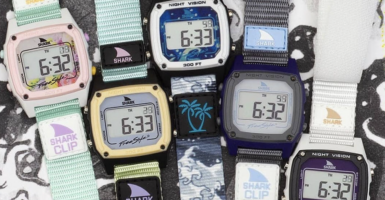Nostalgic photos show how life has changed since the ’40s
Around the world, the 1940s were some revolutionary and history-making years. Not only did the divisive Second World War occur during some of these years, shaping the course of the world, but society began taking larger strides towards the modern civilization that we know today.
Take a trip decades into the past to see what life was really like during the 1940s and the differences and similarities between then and now.
The Calm Before The Storm

While it’s certainly true that music lovers in the ’40s could buy all the equipment and albums they needed to give their homes a soundtrack at stores like this one run by Gordon Gullickson of Washington D.C., that’s not what makes this photo so significant.
Instead, the significance of this photo lies in the month in which it was taken and the meaning behind Gullickson’s facial expression. That’s because this was taken in December 1941, which was the same month of the Pearl Harbor attack and America’s delcration of war on the Axis. So, was this photo taken before the attack on a genuinely normal day for Gullickson, or is he trying to keep himself together amid the horror and uncertainty of what just happened?
Women Took Over The Workforce
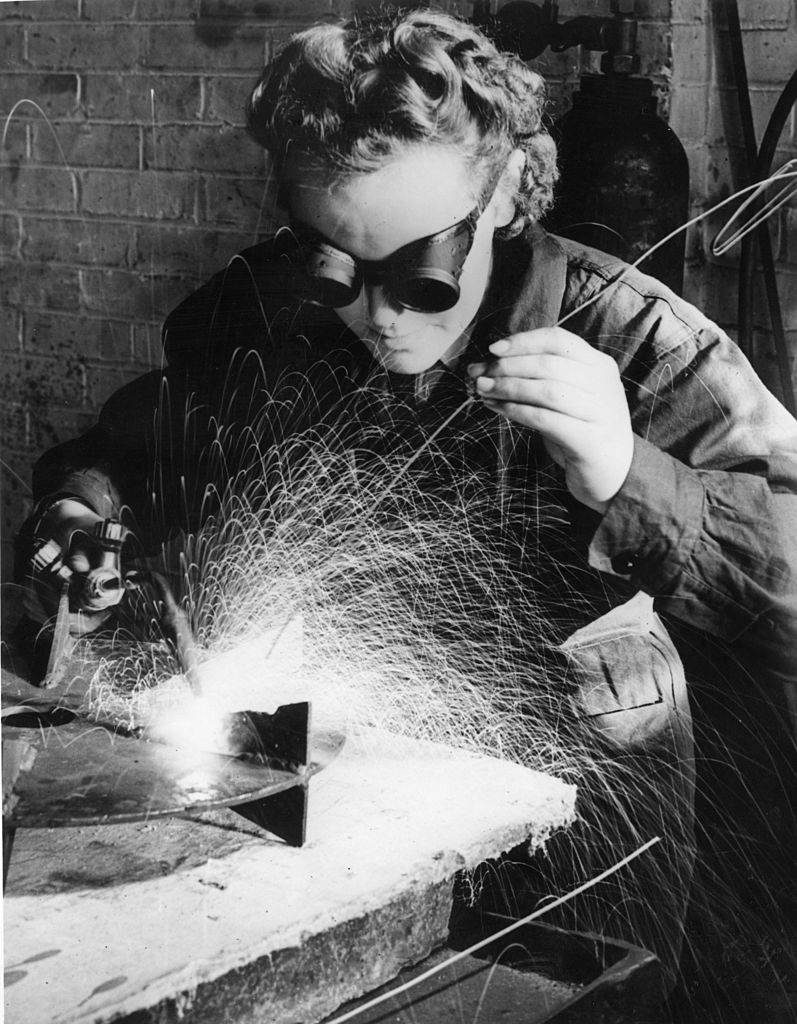
During the tumultuous years surrounding World War II, the United States saw a vast number of able-bodied men leaving their jobs, homes, and families to go fight overseas.
Not only did this leave a massive gap in the workforce, but because of the war effort, more jobs opened more than ever. This resulted in women joining the workforce to support their families to help fill the gap and ensure that the Allies were victorious.
Staying Informed, Electronically
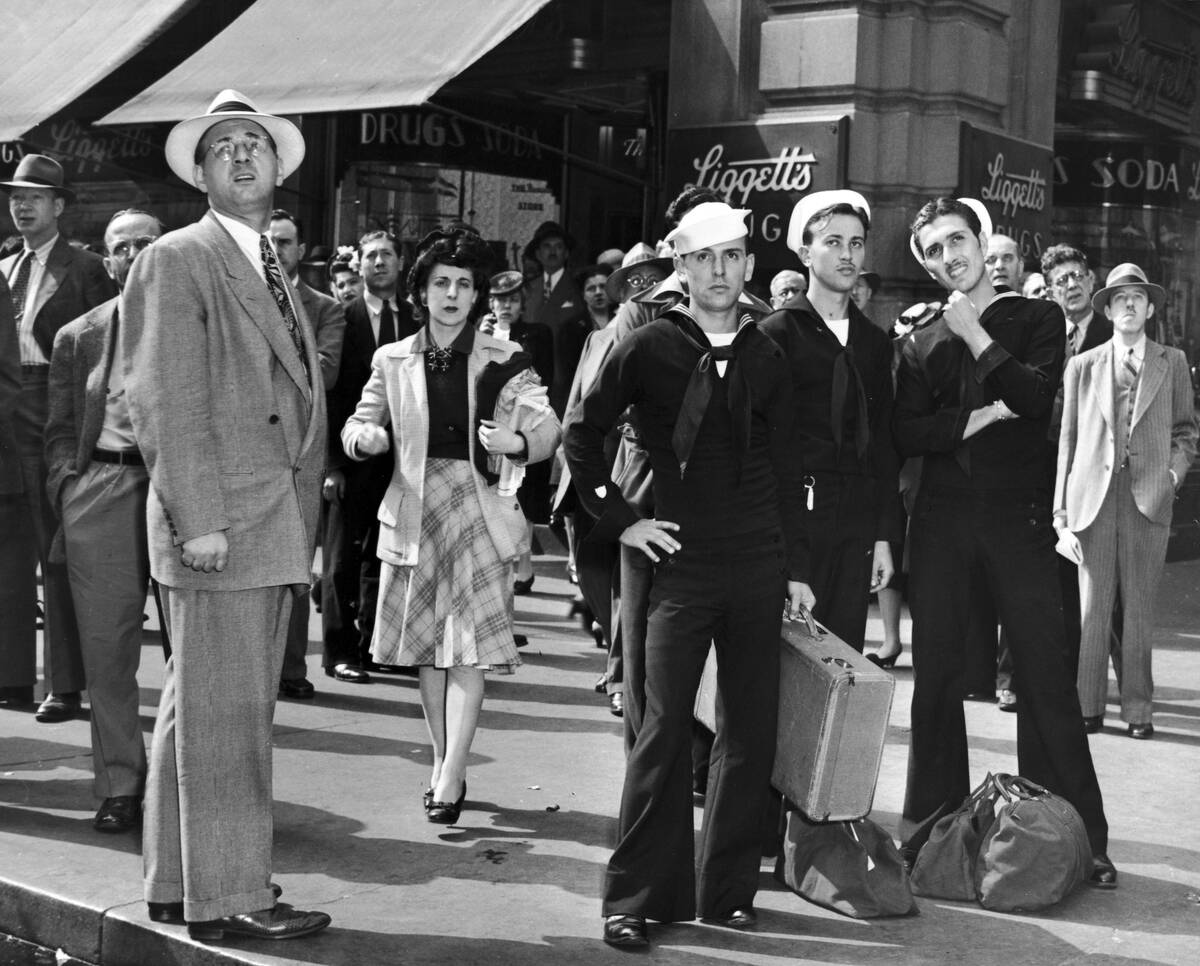
In an era where virtually everyone received their news via the newspaper or radio, there were at least a few more options for those who wanted to stay informed — provided, of course, that they could access them.
This photo shows a group of anxious-looking people, all with eyes trained on the same target: The large electronic sign in Times Square that would display news updates. On this date — June 6, 1944 — they were awaiting updates on the D-Day Invasion in the war’s European Theater.
Production Lines Were Constantly Humming
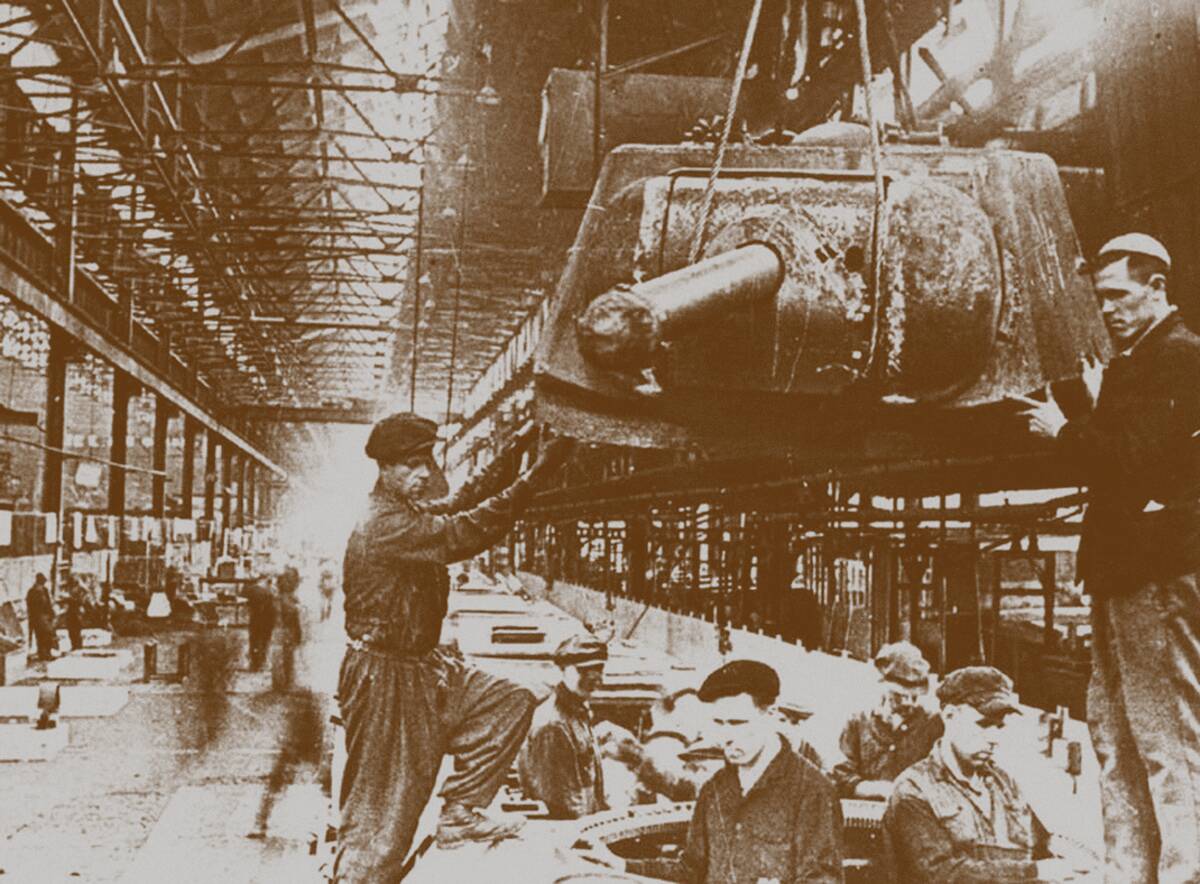
While German tank production tended to be specialized and involve limited runs due to supply deficiencies, both American and Soviet tank production accelerated to an unprecedented degree during World War II.
There’s a decent chance that the workers at this Kirov factory in Chelyabinsk, Russia would have looked stoic anyway, but it seems likely that their grueling workload would contribute to it as well. Considering the needs they needed to meet, their jobs must have been exhausting.
It Was Hard Not To Buy From Them In The ’40s

During both World War I and World War II, the United States was one of the world’s many nations to encourage buying war bonds to ensure the war effort could be funded without raising taxes to an unsustainable degree. They were also intended to help control inflation during wartime.
Naturally, the importance of those bonds to the war effort made it hard to say no when people came by selling them. And in Tyndall Field, Florida, these were the people that a person with that kind of conviction would have to refuse.
The More Things Change…

This photo from July of 1940 shows a man as he climbs the steps to one of Chicago’s L (elevated train) stations. Aside from the wardrobe and vintage signage, Chicago’s L train infrastructure looks much the same today.
By this point, while the L was critically important to Chicago’s transportation network, it was old news. The first line opened all the way back in 1892, and by the 1940s, the L had grown into a dense network that connected not just the city core, but also various suburbs.
Hanging Around In The Barracks
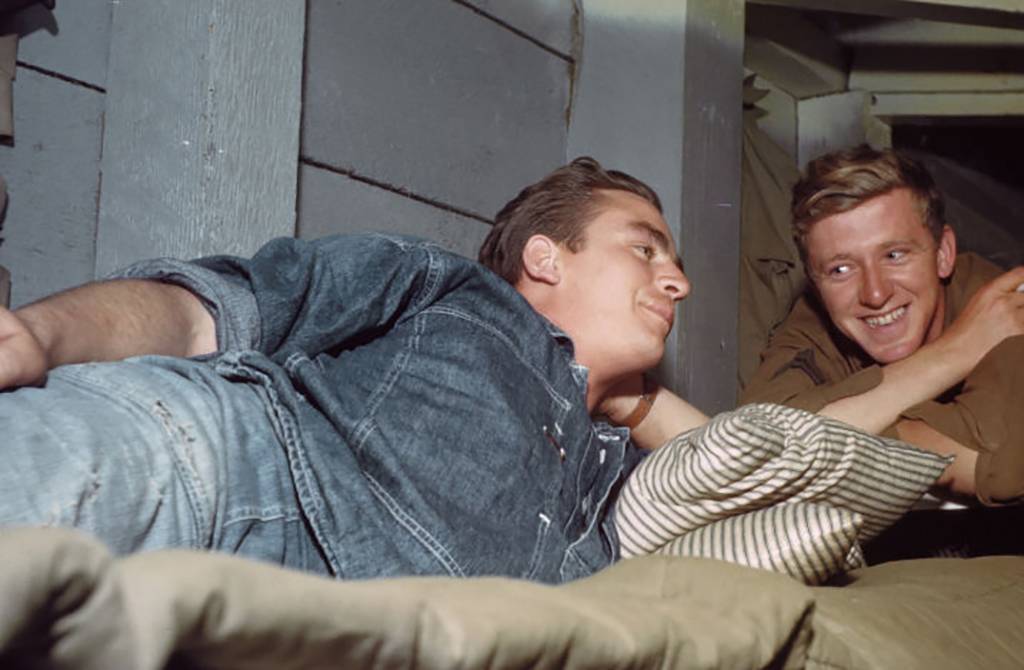
One thing that some people don’t know about the military is that there can be a lot of downtime when not in action.
This photo is a perfect example of just that. In 1940, the number of soldiers at Fort Bragg, North Carolina, had a massive increase, going from just 5,400 to 67,000 men in just one year! With such close quarters, the men didn’t have any other choice than to befriend their fellow soldiers surrounding them.
The Glamour of Old Hollywood
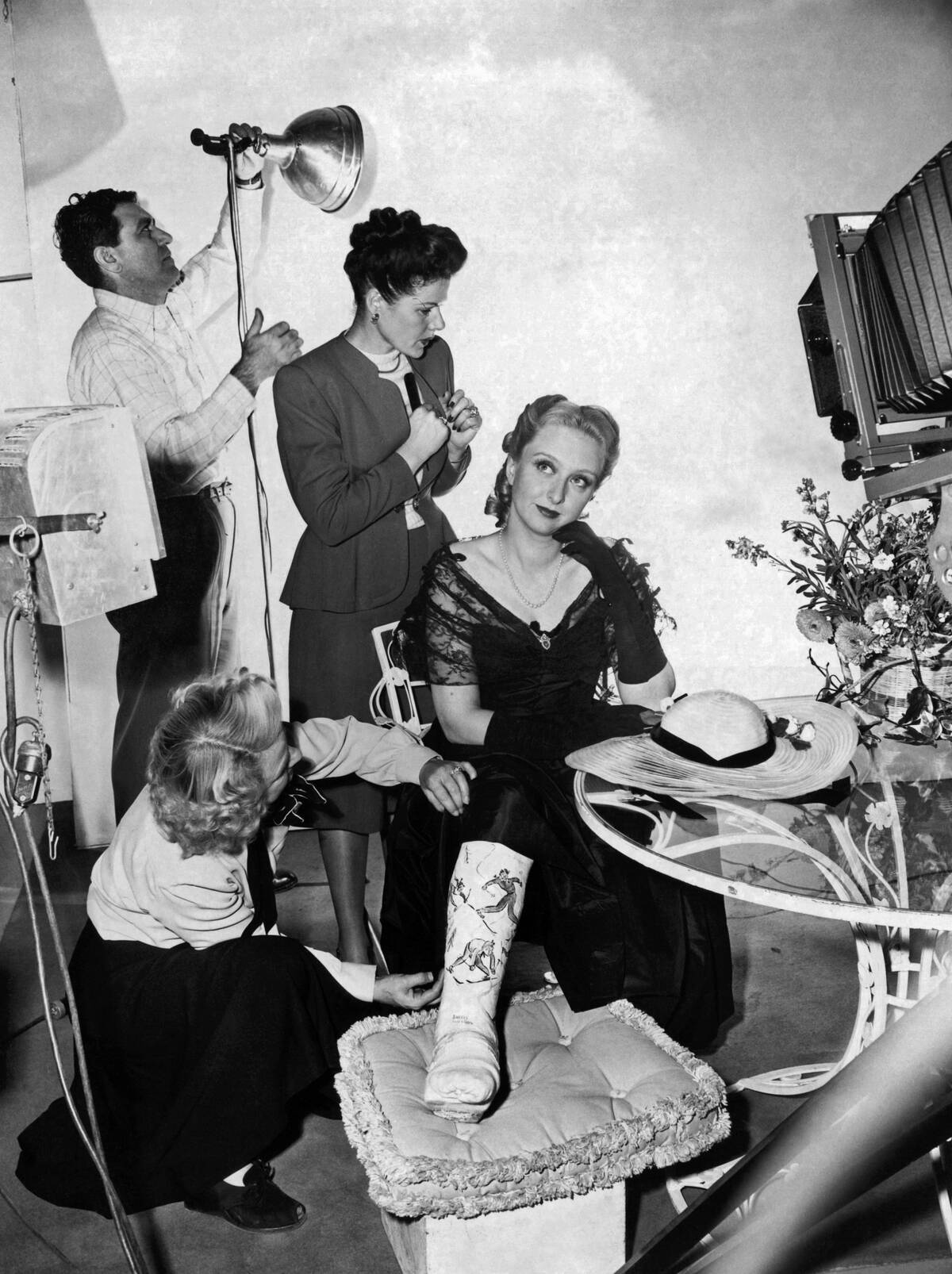
Today, actress Celeste Holm isn’t as well-remembered as some of her contemporaries, but she was still a major star of the 1940s, best known for her role in 1947’s Gentlemen’s Agreement — a movie that won the Academy Award for Best Picture.
This image shows Holm the following year, in 1948, as she gets ready for a portrait session. A hairstylist, costumer, and lighting technician are all working to make sure she looks her best.
It Must Have Been A Special Occasion

Although it was hard to look one’s best during the extreme austerity of the Great Depression and the rationing of World War II, some couples even in humble-looking areas like this managed.
The occasion they were celebrating is unclear but it must have been a big event because the man in this photo looks so crisp and dapper in his suit, while the lady with him looks positively elegant in her evening gown. Vintage fashions keep coming back for a reason.
Two Cultures Collide

It’s safe to say that neither motorcycle culture nor stock car culture were top of mind in the 1940s — but this 1947 photo shows the genesis for both of them. This couple is riding a pair of Harley-Davidson motorcycles, a form of transport that would become enormously popular in the years that followed.
Adding to the allure of this vintage photo is the fact that it appears to have been snapped on the sand at Daytona Beach. Stock car racing at Daytona Beach became a popular pastime around this time, and in time, Daytona became a stock car mecca.
Tenement Housing Was The Norm
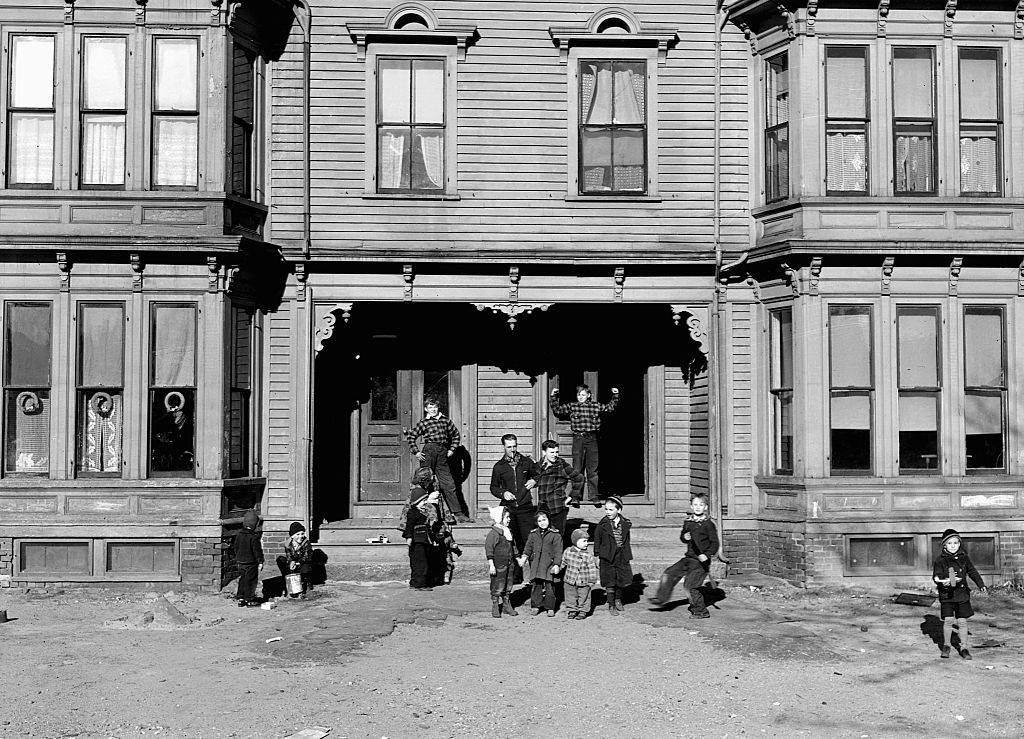
During the 1940s, more and more people began immigrating to the United States for a variety of reasons, with World War II being one of them. The increase in population led to the further development of affordable housing.
Because housing was so cheap, it meant that the homes weren’t the greatest. Referred to as tenement homes, these housing developments were small, and usually had no plumbing or proper lighting. Folks would typically try to fit as many people in one as possible.
Riding In Airplanes Was Like Flying In A Five-Star Hotel
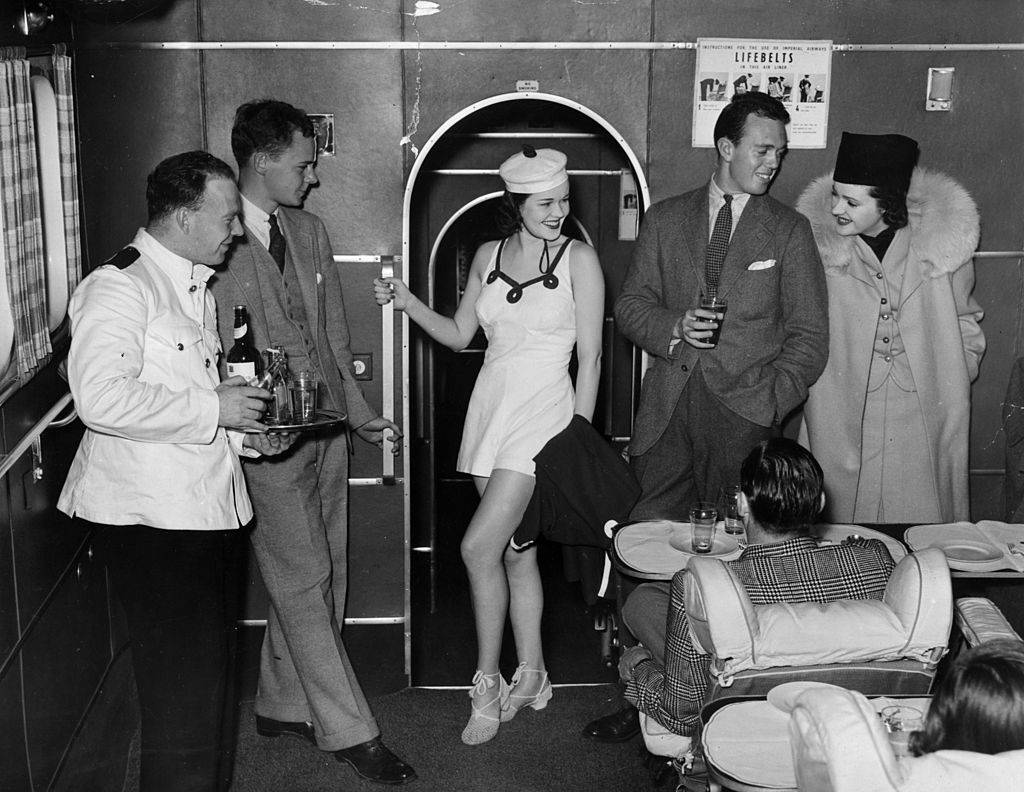
Unless you’re flying first class, and even if you are, many people still dread going on airplanes. They’re cramped, the food is bad, you’re packed in like sardines with strangers, and the whole process is stressful.
However, back in the 1940s, riding in an airplane was a luxurious experience, at least for those who could afford it. Passengers traveled in style and were treated like royalty, having all their needs met by a finely-dressed crew.
Joltin’ Joe Adds To His Legend

Yankees legend Joe DiMaggio was already one of the best baseball players in the world by 1941 — his sixth year in the league — but it was his legendary hitting streak that same year that helped to establish his legendary status.
This photo shows DiMaggio crossing the plate after a home run, extending his hitting streak to 46 consecutive games. His streak would end at 56 games, a mark that’s still a Major League Baseball record.
Cars Weren’t The Norm
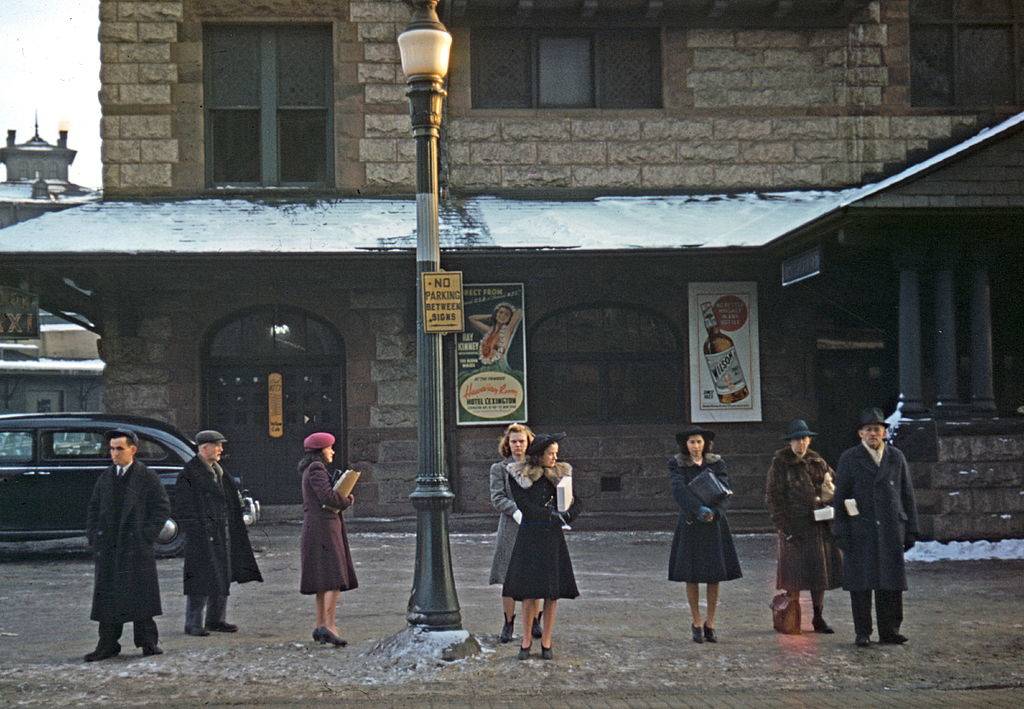
While most people today have cars to get around (even if they don’t have all that much money), in the 1940s, cars were primarily owned by the wealthy. For the most part, people relied on public transportation.
Yes, that meant scheduling their days around the times of buses, trains, and other modes of transportation. This picture shows a group of commuters waiting for the train in Lowell, Massachusetts, for the ride home after a long day at work.
When Wireless Was Only In Science-Fiction
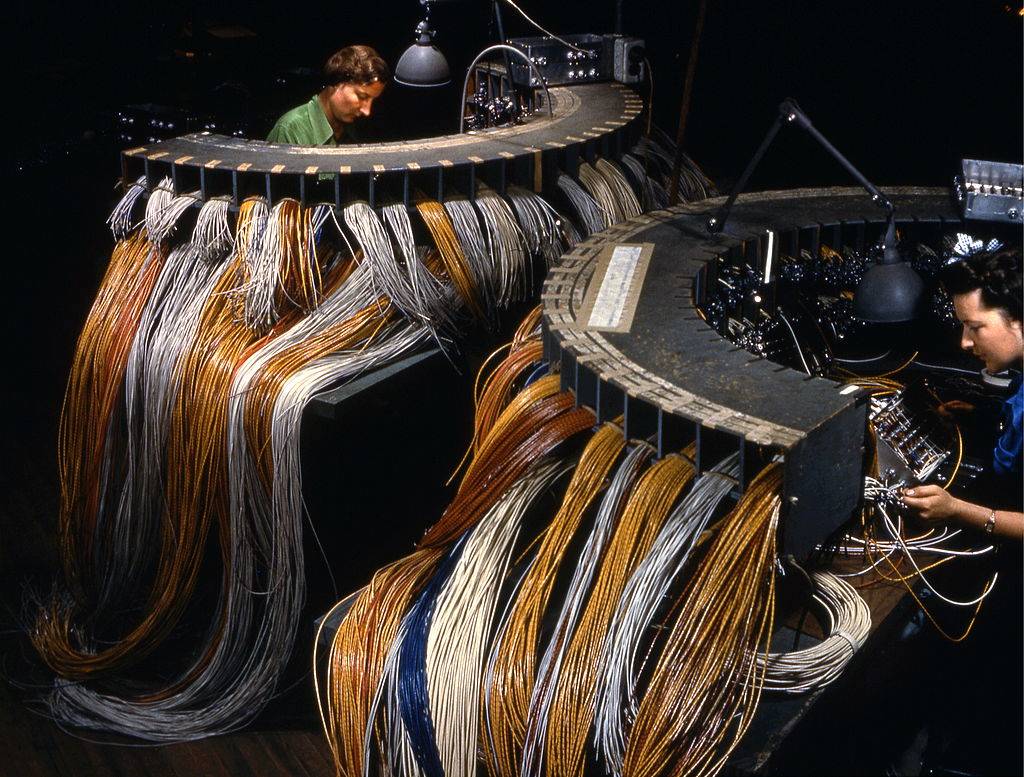
On top of all the mechanics, logistics, and skills that go into getting a fighting aircraft off the ground, it’s easy to forget all of the electrical work that has to be done back on the base.
Here, women receive and send messages to control all of these electronic components while working at their posts on a PB2Y patrol bomber. This was certainly no easy job, and we should all feel lucky we don’t have to do it.
This Blizzard Foiled Christmas Plans
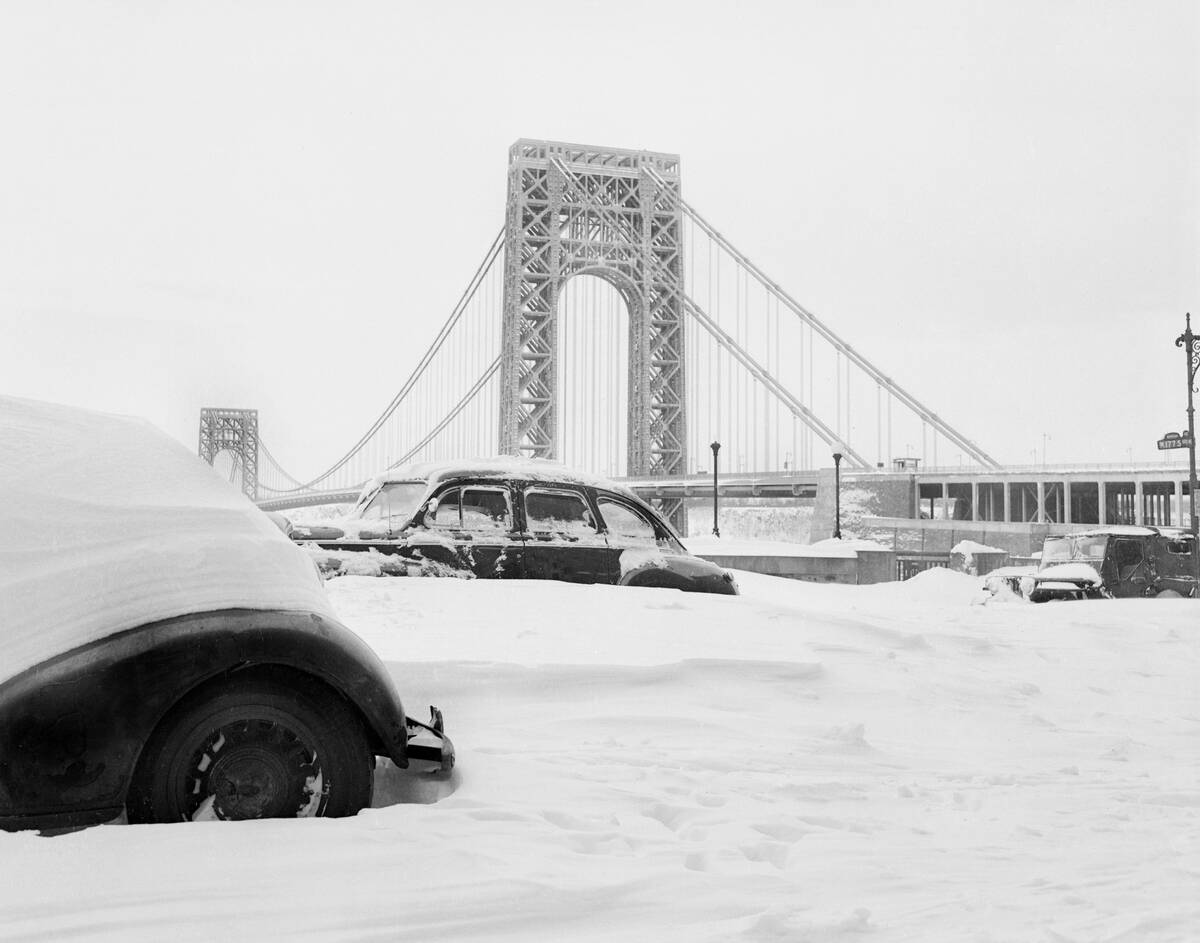
The bridge in the background of this photo is immediately recognizable as New York’s George Washington Bridge, and the amount of snow makes it clear that the cars in this lot won’t be going anywhere soon.
While New York is no stranger to snowstorms, this 1948 blizzard came at an incredibly inconvenient time: Just after Christmas Day, a time when many New Yorkers were traveling into or out of the city.
Schools Weren’t Like They Are Today
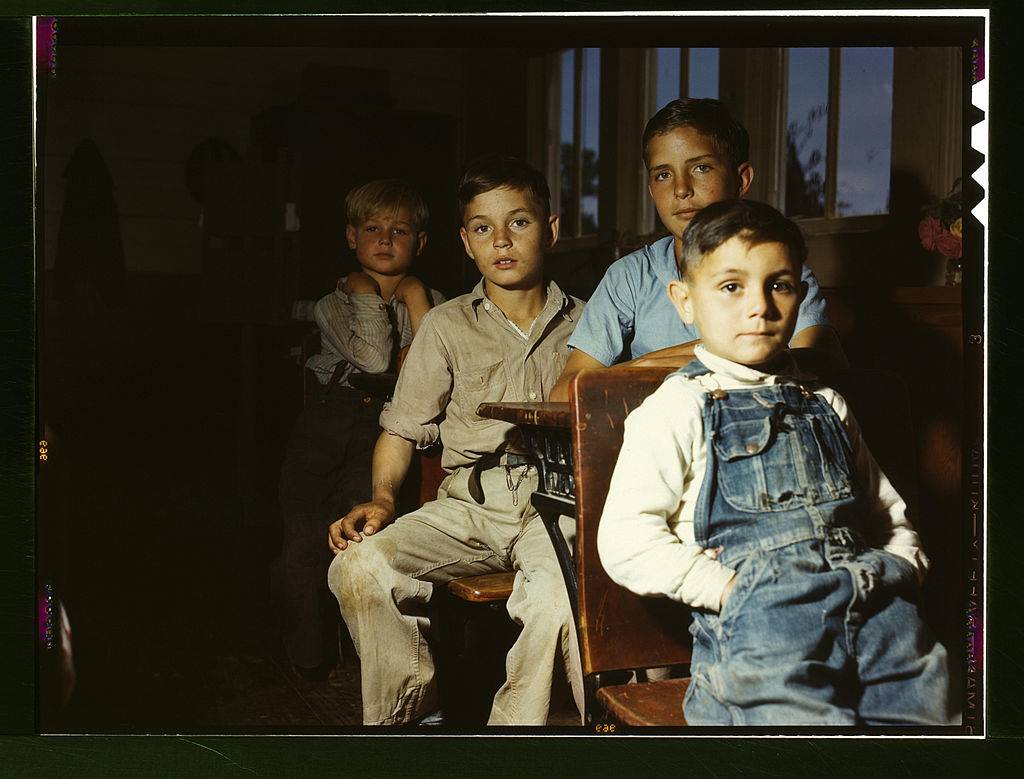
Back in the 1940s, the school system was not nearly as organized or important as it is today, especially in rural areas. In these specific parts of the country, children were lucky to go to school instead of staying at home and helping out with the work in the fields.
Pictured here are students attending one of these rural schools in San Augustine Country, Texas, in 1943. More than likely, they still had work to do that evening.
The Push For War Bonds Was On
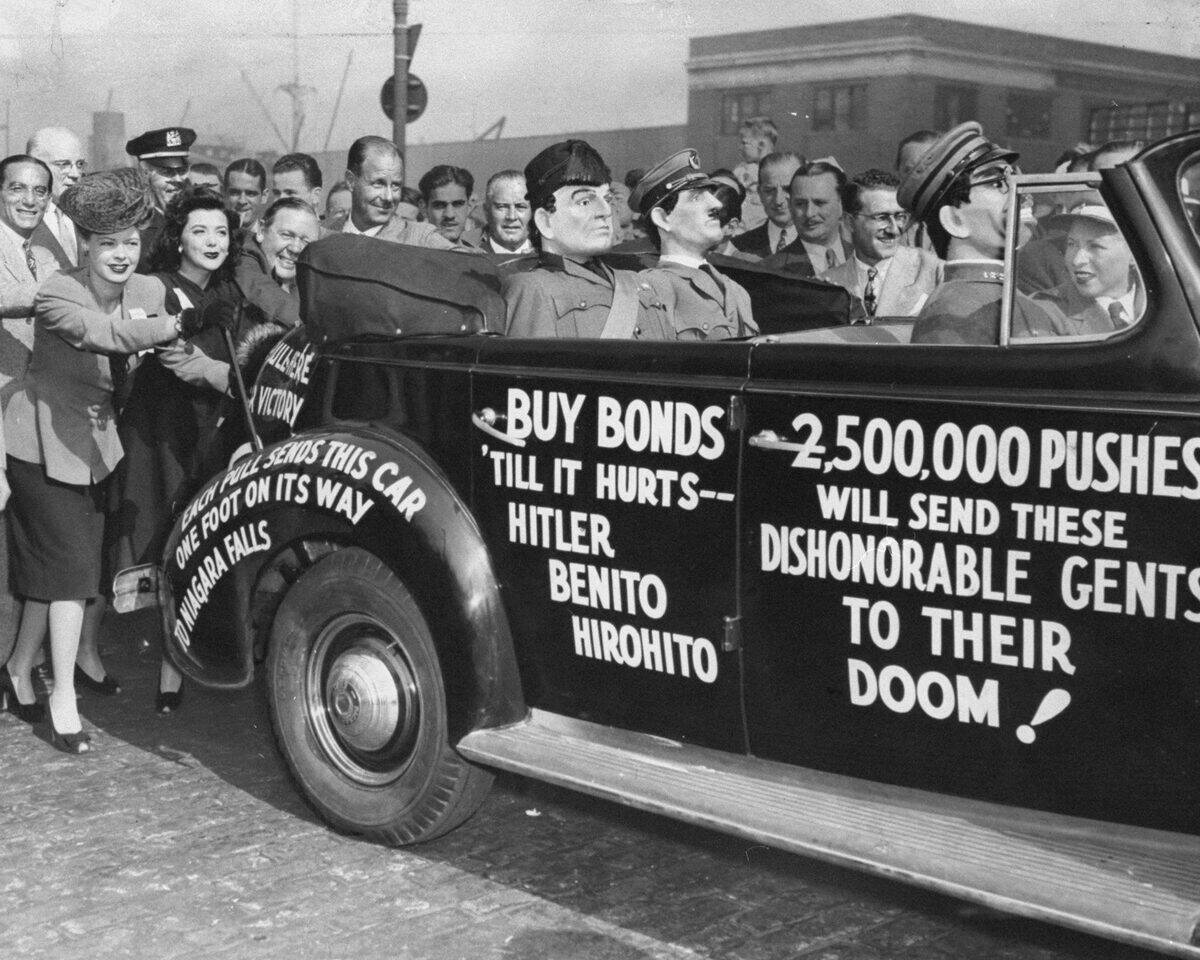
During the World War II years, civilians in the United States were urged to donate whatever they could spare to the war effort. To help encourage them to give, local governments and businesses did whatever they could to raise interest.
This image shows a car advertising the war effort, complete with mannequins to serve as caricatures of Axis leaders. The photo caption says that the car’s final destination was Niagara Falls, where it was to be destroyed.
A Barrage Balloon Overhead
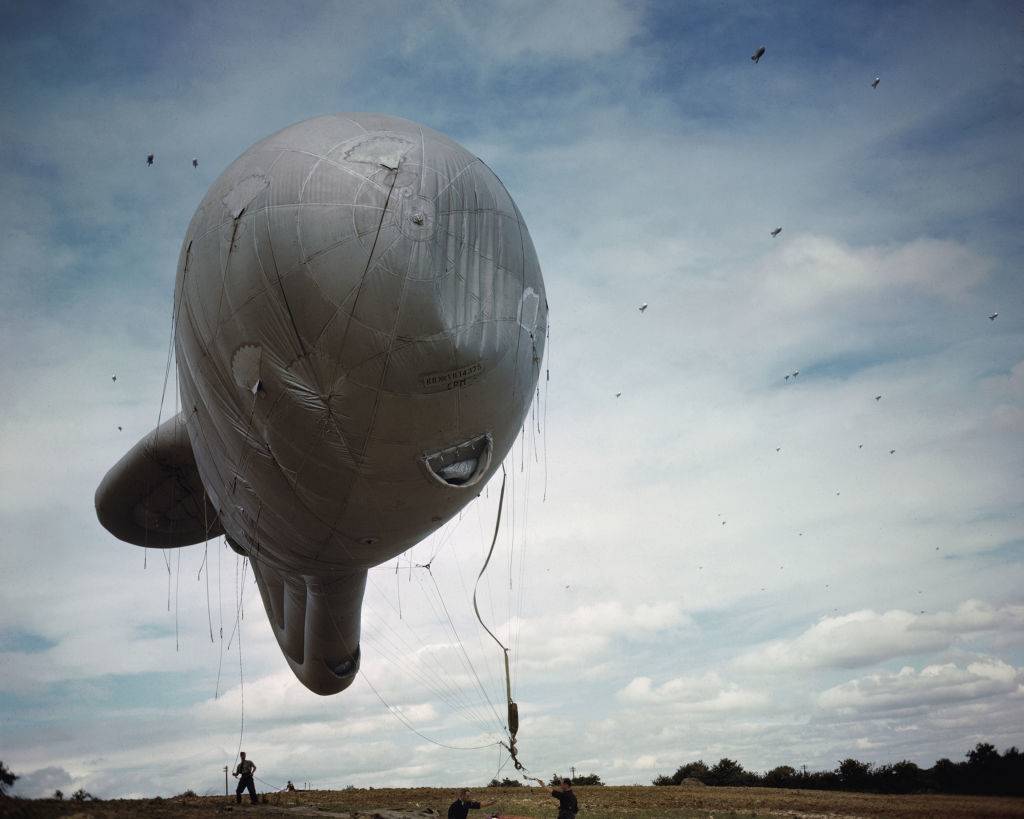
A barrage balloon is a kite balloon that was utilized to defend ground targets against enemy aircraft. They were tethered to the ground using steel cables, which posed a major risk to aircraft that made an attempt to fly through them.
Taken from the design of the initial kite balloon, this new shape meant that it could be operated even if there was wind, unlike the regular circular balloon. These were heavily used during World War II.
The Jitterbug Was All the Rage
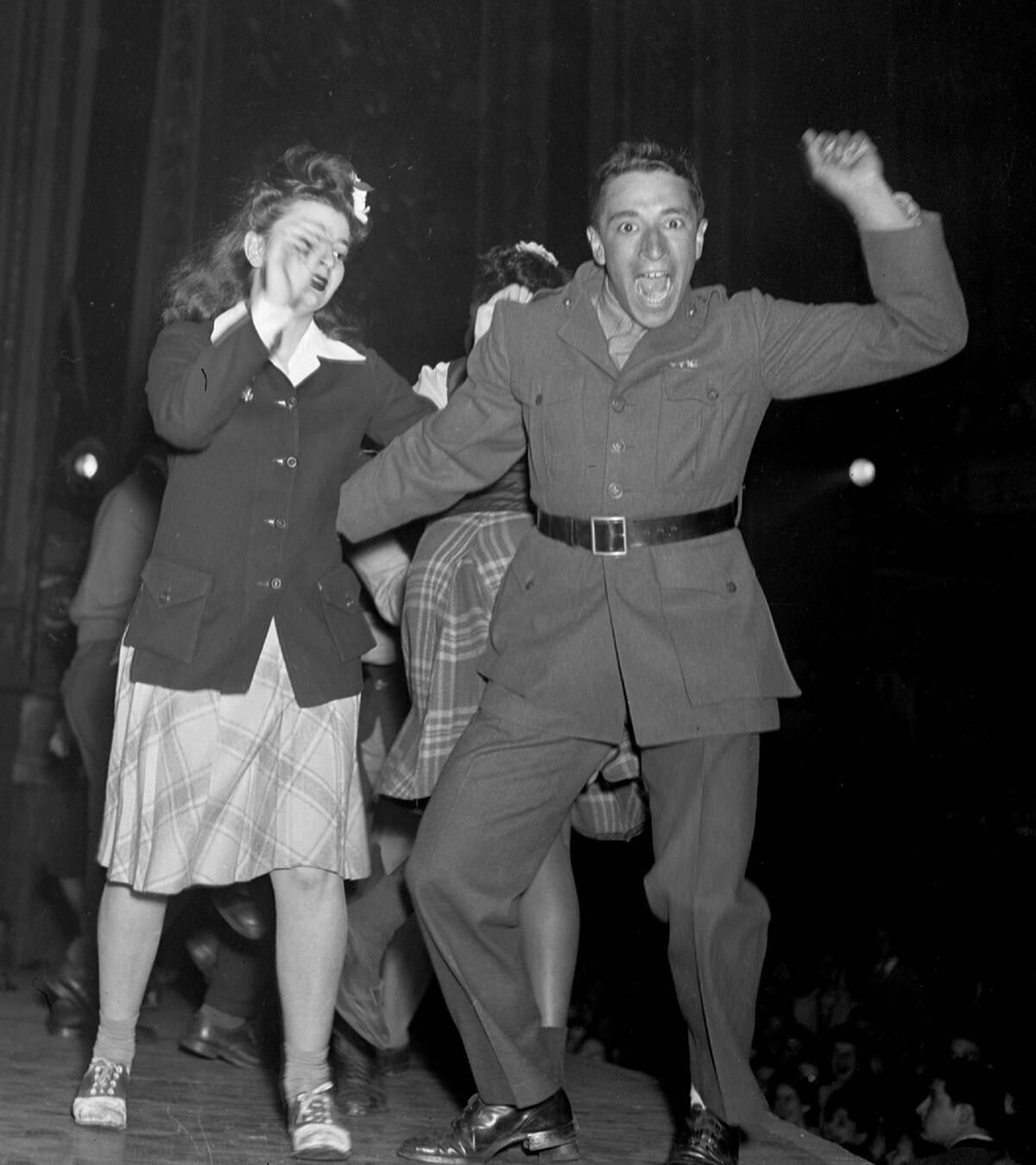
Dance crazes pop up periodically, and one of the most popular trends of the 1940s was the jitterbug — an energetic dance that evolved from the Lindy Hop.
The jitterbug paired perfectly with the brassy big band music of the era, and because its popularity dovetailed with the war years, it became a popular dance for civilians and servicemen alike.
A Weapon That Was About To Make Life In Japan Harder
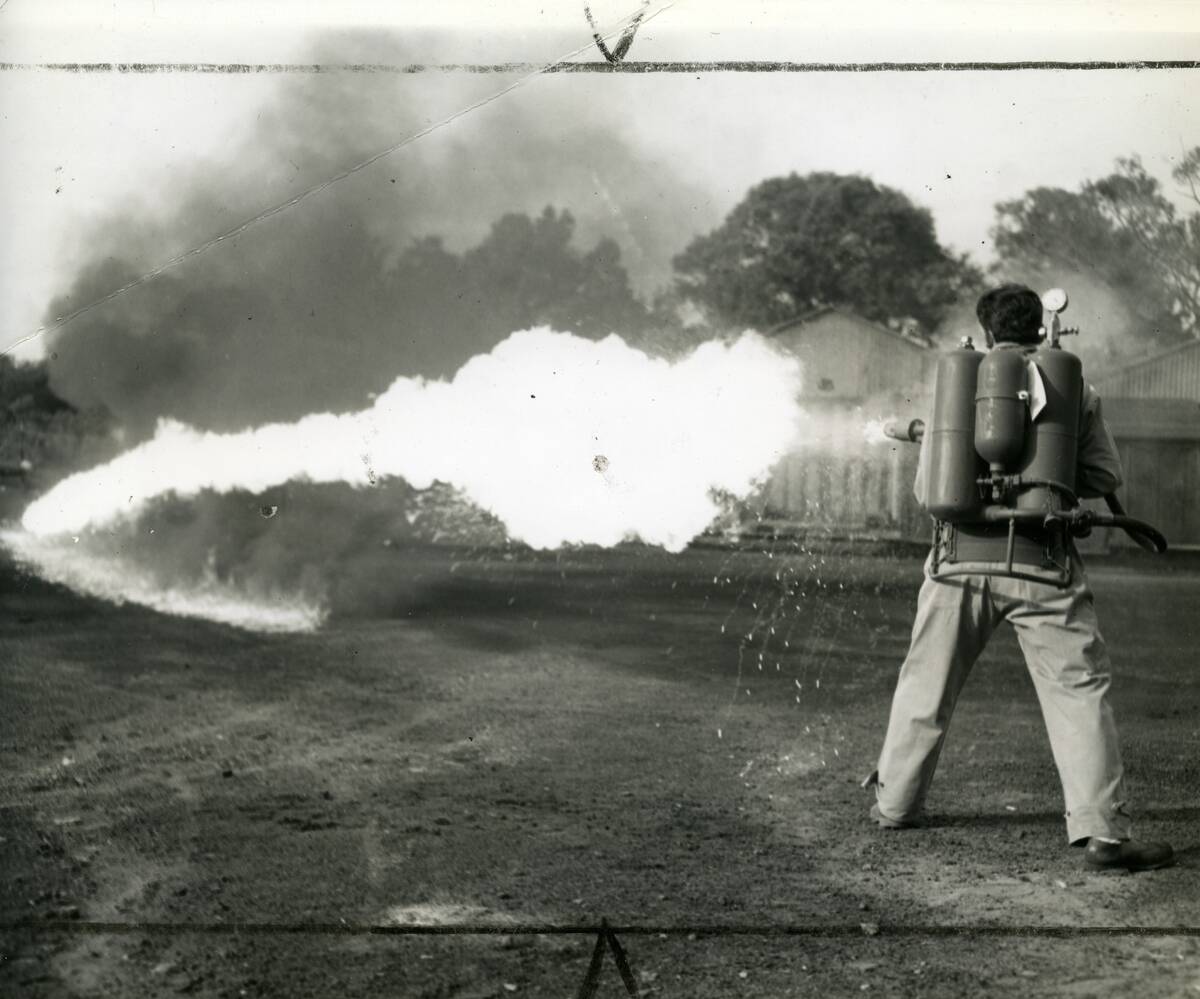
In winter of 1944, the Chemical Warfare Service developed a fearsome flamethrower that was rushed into production and eventually released in May 1945. It was manufactured by Beattie Mfg Company, which operated out of Little Falls, New Jersey.
The flamethrower was designed for the Pacific Theater, which was handy because by the time this photo was taken on May 24, 1945, V.E. Day had already taken place. Since V.J. Day was three months later, it’s likely that the flamethrower saw at least some use of the Japanese home islands.
People In Occupied Territories Did What They Had To

Although experiences under German occupation varied from place to place (and given the politics of the German high command, from race to race), there was nonetheless a prevailing sense of hardship in most occupied territories. Indeed, the most pernicious issue in these lands was the malnourishment of the local populace.
Details are sparse about this photo but that may very well be a motivation for this Austrian couple’s decision to go in disguise. Presumably, the woman at right would also hide her hair in her cap, as her gender would otherwise be a dead giveaway. Although the German army did include female support units called Wehrmachthelferin, they didn’t wear this particular uniform.
New York’s Legendary Mayor

Fiorello La Guardia served as New York’s mayor between 1934 and 1945, overseeing the city through not just the Great Depression, but also World War II. This 1941 photo shows him savoring the results of his most recent re-election campaign.
While most New Yorkers today only recognize him because one of the city’s airports was named after him, La Guardia oversaw numerous public works projects and was a key driver of New Deal policies.
Don’t Be On The Other Side!
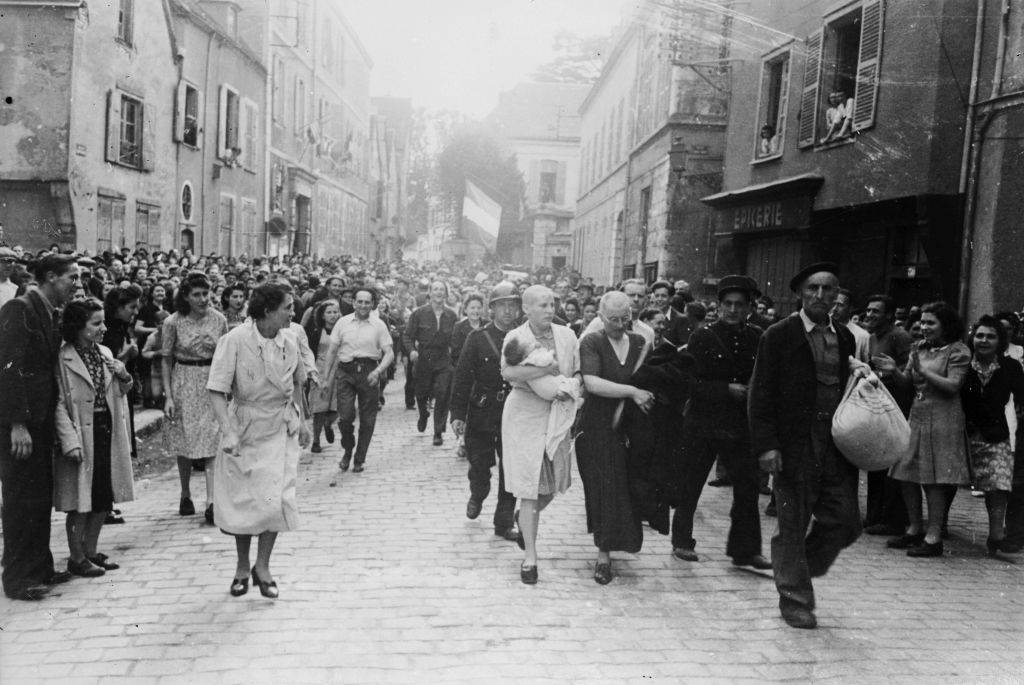
Following World War II, those not on the side of the Allies or who helped the German forces were publicly shamed, particularly in Europe. To have sided with the Axis may as well have been heresy, and those that did were treated as such.
Here, in a town in Europe, women that corroborated with the German oppressors are being marched through the streets in front of everyone. This image was taken in Charters, France.
Ride At Your Own Risk

Although today, there are rollercoasters that appear to be the most dangerous thing you could strap into, in reality, they’re quite safe. Intense inspections and codes are set in place to ensure nothing bad happens.
In the ’40s, let’s just say the rules were a little more relaxed. Rides were basically set up and operated on the spot without much outside management. Regardless of the risk, plenty of people were still eager to ride.
Baseball Saw a Youth Movement
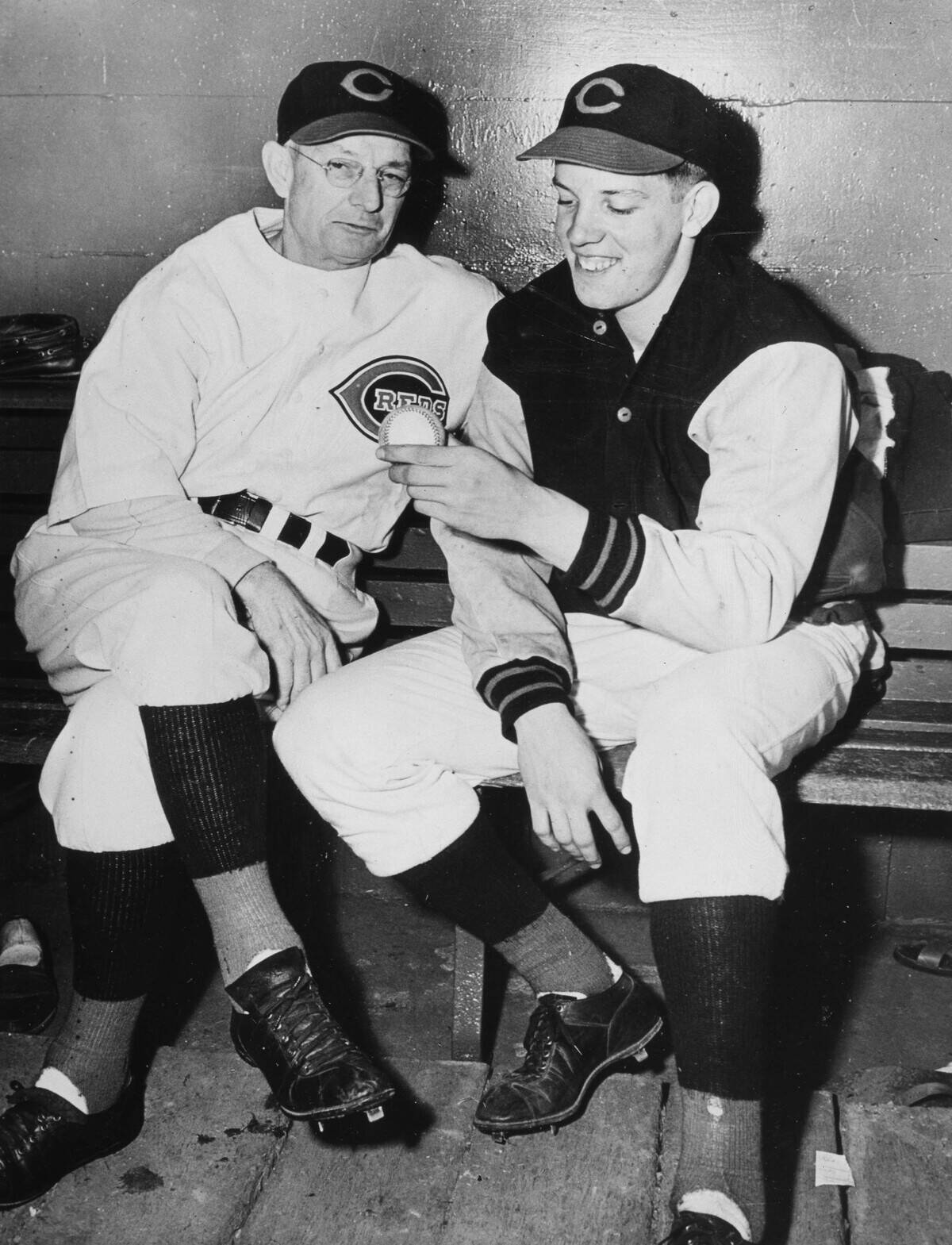
With so many baseball stars drafted into the armed services, there were questions about whether Major League Baseball would survive the war years. During these lean times, teams consisted of players who weren’t eligible for the draft, or — in some cases — those who were too young to be drafted.
This reached an absurd level in 1944, when the Cincinnati Reds recruited 15-year-old Joe Nuxhall to pitch for them. While the high schooler wouldn’t fare well during his debut, he would return the following decade and have a serviceable baseball career.
Trampolines Existed But They Weren’t Everywhere
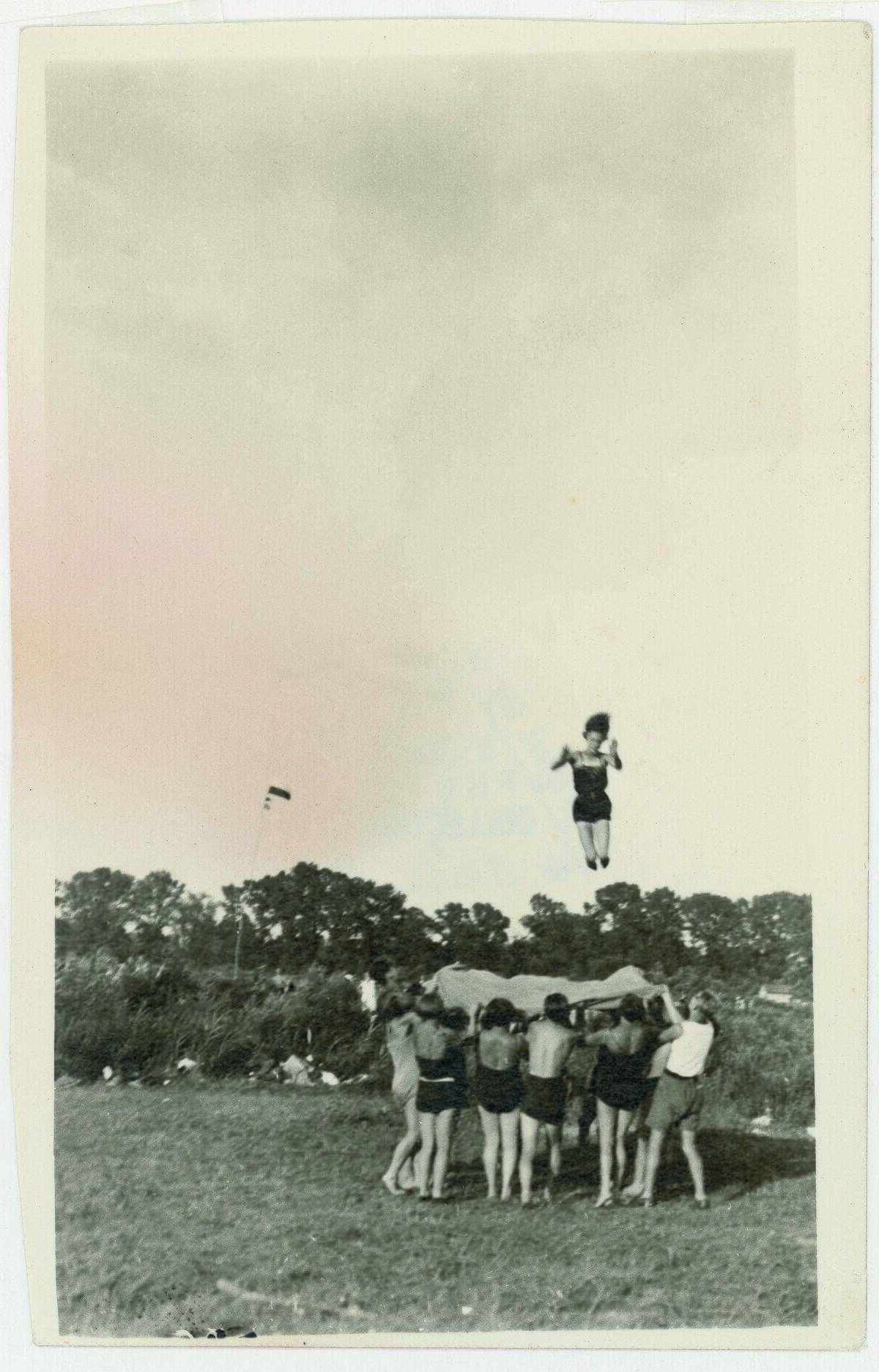
This picture depicts a group of German youths using thick blankets to launch their friend in the air, much like a trampoline could later accomplish on its own. Those devices were actually known as “rebound tumblers,” at the time, as the name “trampoline” was trademarked.
It would have been possible for some kids in America at the time to have this kind of experience without involving ten of their friends, as the Griswold-Nissen Trampoline & Tumbling Company first made trampolines commercially available in 1942. However, since the United States was at war with Germany at the time, these kids wouldn’t get one.
Fairs Were A Popular Attraction
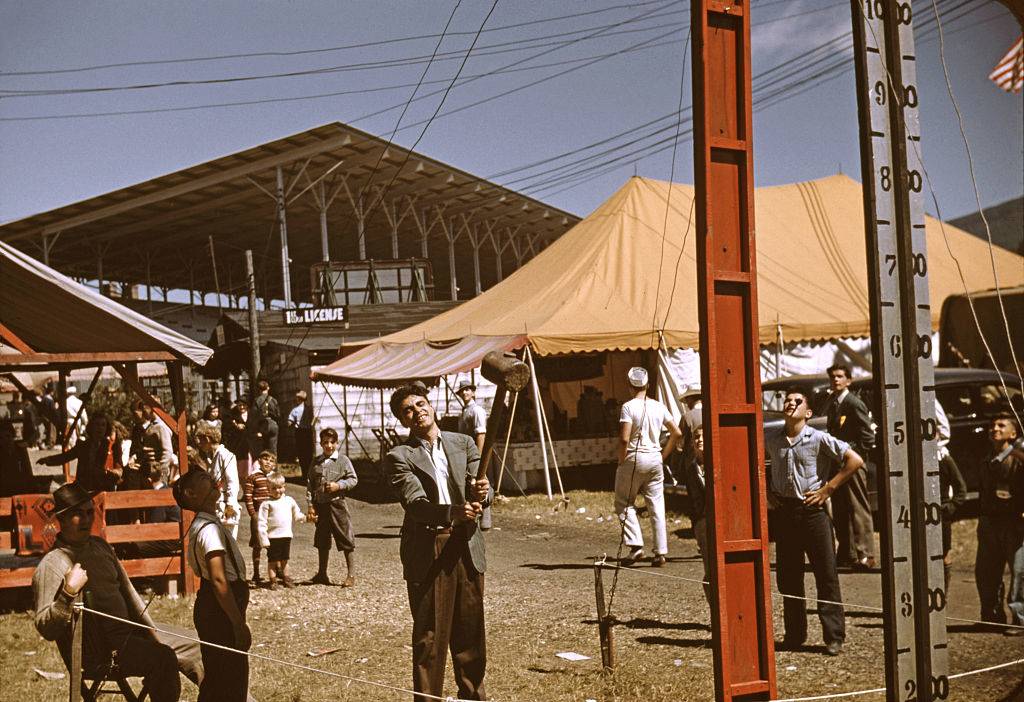
Unfortunately, most state fairs ended up being closed during World War II in order to focus on the war effort. However, at the end of the decade, they experienced an explosion in popularity, bringing them back to the forefront of the entertainment industry.
Featured here is a fair attendee in Vermont about to try his hand at ringing the bell with the hammer. It’s safe to assume he’s trying to impress someone that’s watching on the sideline.
Elizabeth II Wasn’t Always Queen
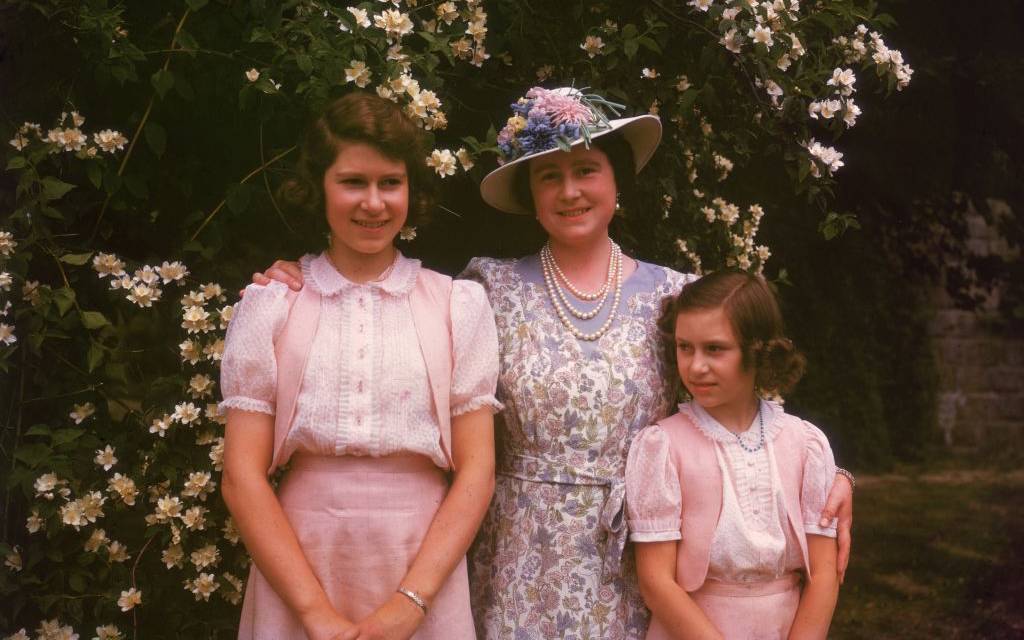
Featured in this photograph is the original Queen Elizabeth and her two daughters, Princesses Elizabeth and Margaret, on the grounds of Windsor Castle.
Little does Elizabeth know just what an extensive reign her future held! Even at a glance, we can tell this is Elizabeth!
This Wasn’t A Weapon, It Saved Lives
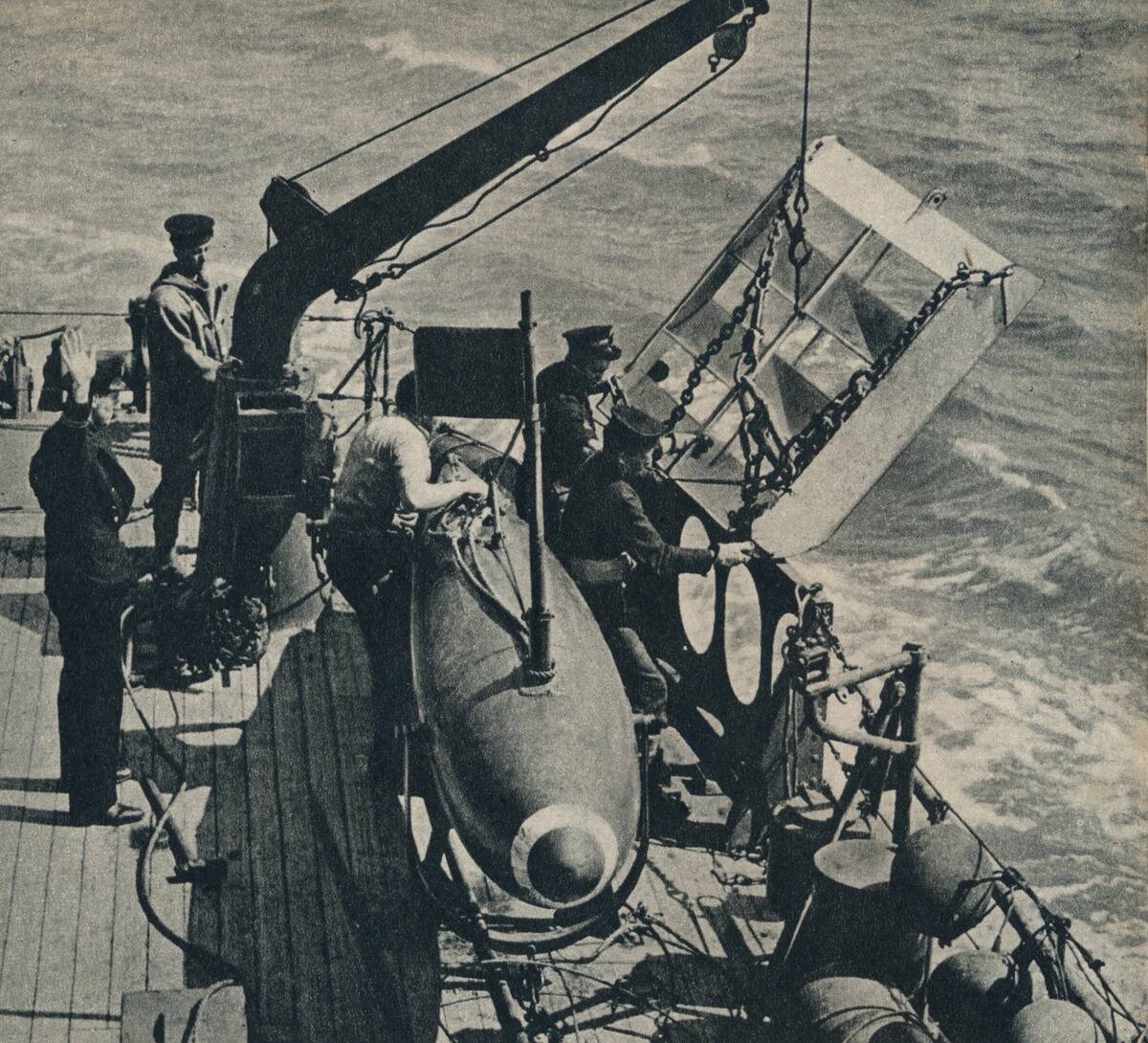
While this stubby, tubular device looks like a torpedo of some kind, it actually has the complete opposite purpose. That’s because the British boat it’s aboard is part of Her Majesty’s Minesweepers, a class of vessels specifically intended to disable aquatic mines.
The tubular float is needed for the Oropesa method of minesweeping, which involves dragging it behind the ship. The float is equipped with cutters used the cut the mooring cables of mines, which makes them easier to spot when they float to the surface.
Just Like Our Ancestors
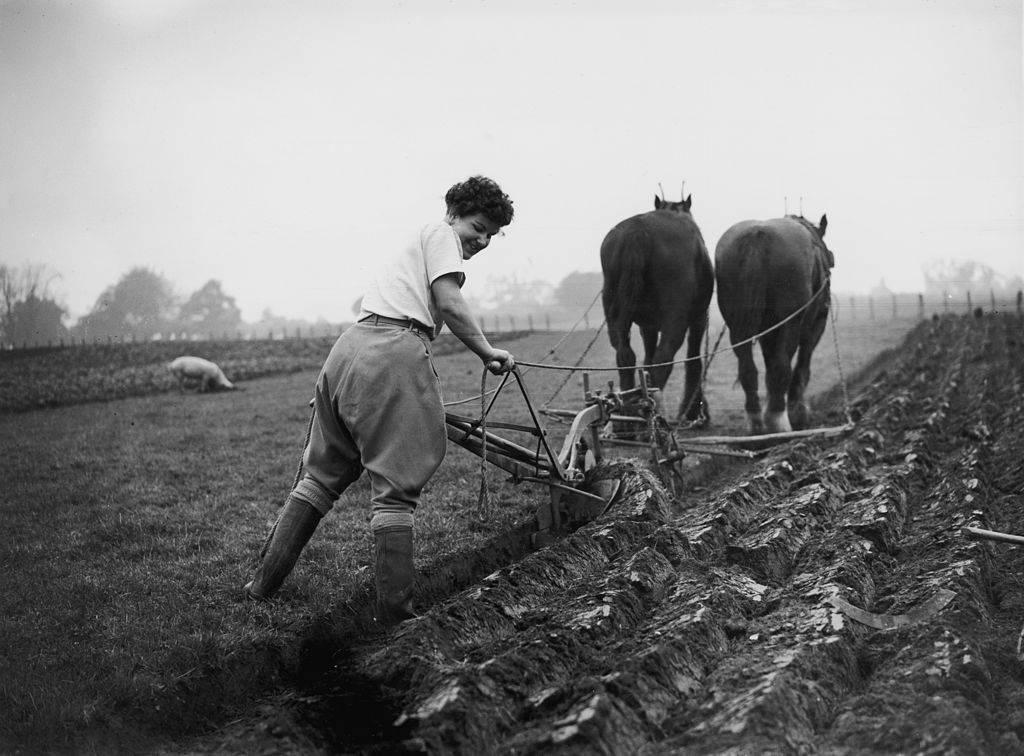
If only the wealthy had cars in the 1940s, you could imagine that only the richest of farmers had access to a mechanical tractor. Back then, horses and mules were still used to plow fields, as they have been for thousands of years.
At the time, farmers probably didn’t know what farming would look like in the future or imagine a life without their trusty livestock. While this picture might as well have been taken back hundreds of years, it’s actually the 1940s!
A Moment Of Whimsy During A Tough Time

This man’s wardrobe is exactly what men were typically expected to wear when out in public during the 1940s, but that doesn’t mean their personalities always matched the rigidity of those expectations.
For instance, here is a pretty adorable moment that found this man standing on a bench so he could reach up and feed the pelicans perched above this hut. That bird always looks pretty funny when it’s eating and it’s clear this man agreed.
Anything To Make A Dime

After the discovery and production of penicillin it helped to cure countless people of their ailments. However, during the 1940s, in order to attain it, you still needed a doctor’s prescription, and it had to be administered by an actual physician.
This picture shows a man putting up a false advertising sign because penicillin was yet to be made available over the counter. We can assume this gentleman made a pretty penny from this lie.
This Wasn’t Taken Where People Might Think
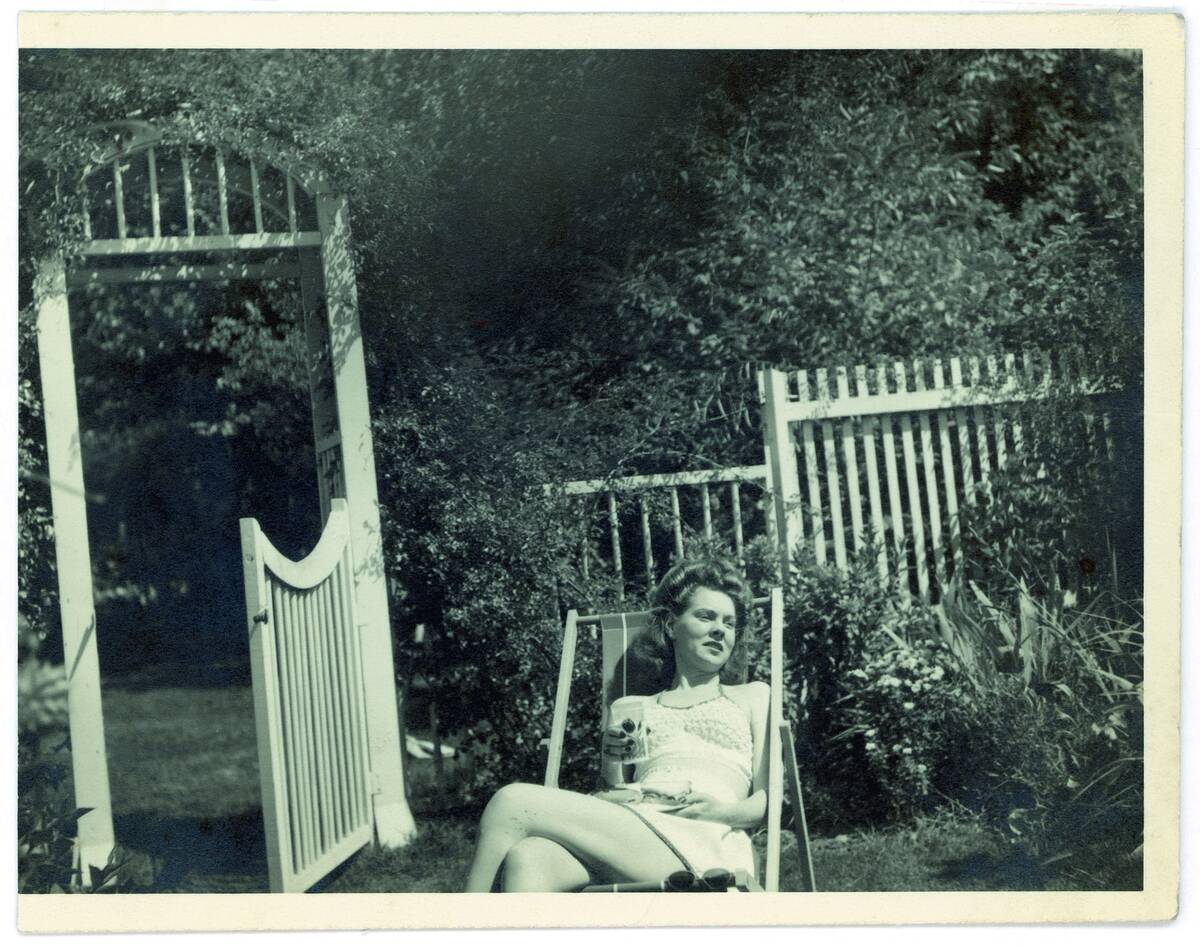
In films set in World War II, 1940s Germany is often depicted as a harsh, grimy place where oppression is an everyday reality and life has an overcast gloom over it. Indeed, that’s precisely what life in the nation felt like for the millions that its government persecuted.
However, that didn’t mean this matched everyone’s experience during the war years. That disconnect can be jarring enough that Germany would likely be the last place many people would have expected this photo to be taken in.
All-Natural Ice Skating
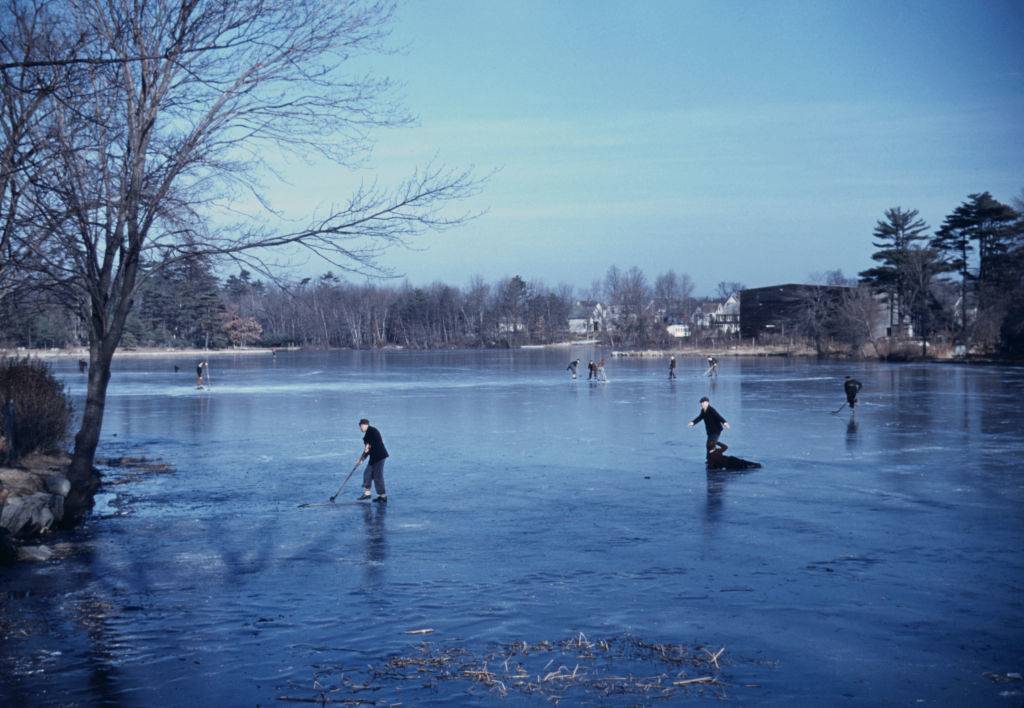
Although it’s safe to say that ice skating has decreased in popularity in recent decades, when we typically do see people ice skating, it’s usually on constructed rinks and during the holidays.
Rewind back to the 1940s, and not only was ice skating popular, but people just did it wherever the ice was thick enough to skate on! This may have seemed like no big deal at the time, but you wouldn’t catch most people doing that these days!
A Venerable Tradition That Was Pretty New At The Time
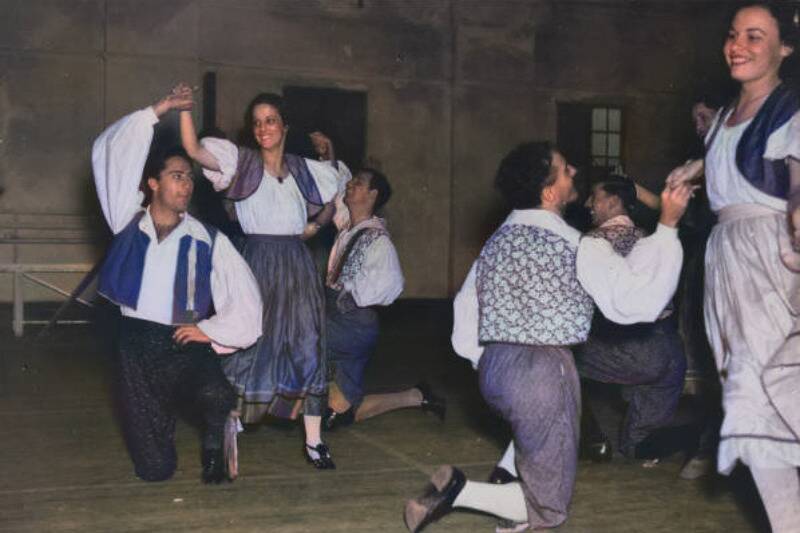
These folk dancers from 1940 were participating in a traditional festival that was only barely traditional by the time this was taken. Don’t let the colorization fool you. It’s the National Rice Festival in Crowley, Louisiana, which had only begun three years before this photo.
Indeed, it seemed that this was perhaps the festival’s most uncertain decade, as it was put on hiatus after the United States entered World War II a year later. Nonetheless, it came back in 1946 as the International Rice Festival, which still goes on to this day.
Women Served In The Military Then, Too
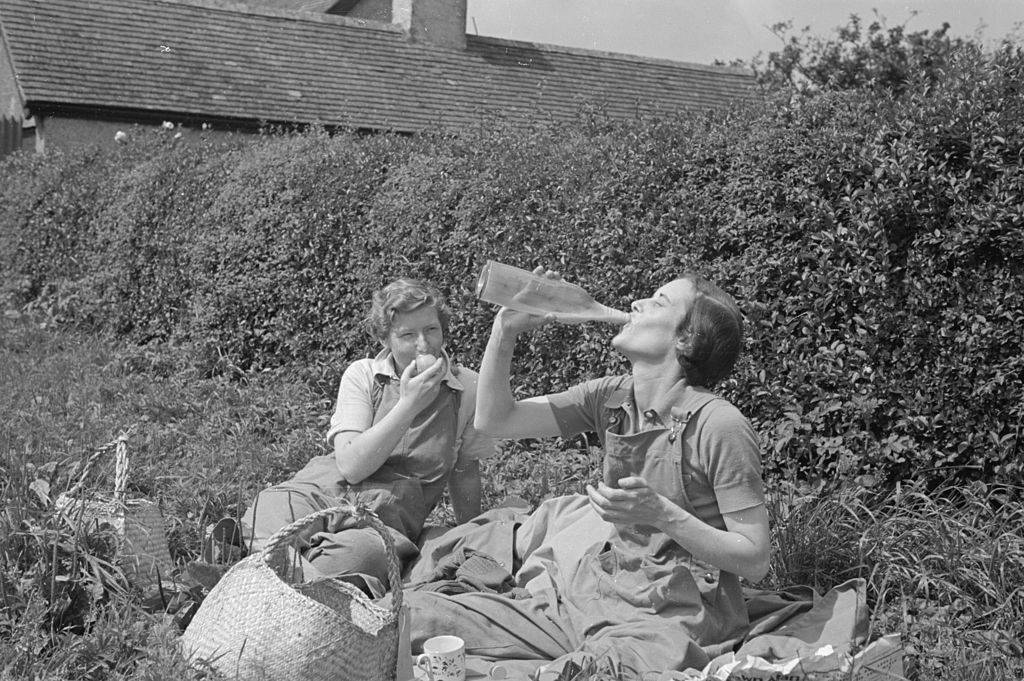
Although when we think of World War II, we usually envision men fighting in both the European and Pacific theaters, women were involved too! Not only were they helping back at home, but some also joined the ranks of the military.
Pictured here are two women enjoying a picnic who are serving as members of the Women’s Land Army. Mostly, they were made up of domestic servants, shop assistants, housewives, teachers, and other similar jobs at the time.
The Start Of A Destructive Practice And A Global Crisis
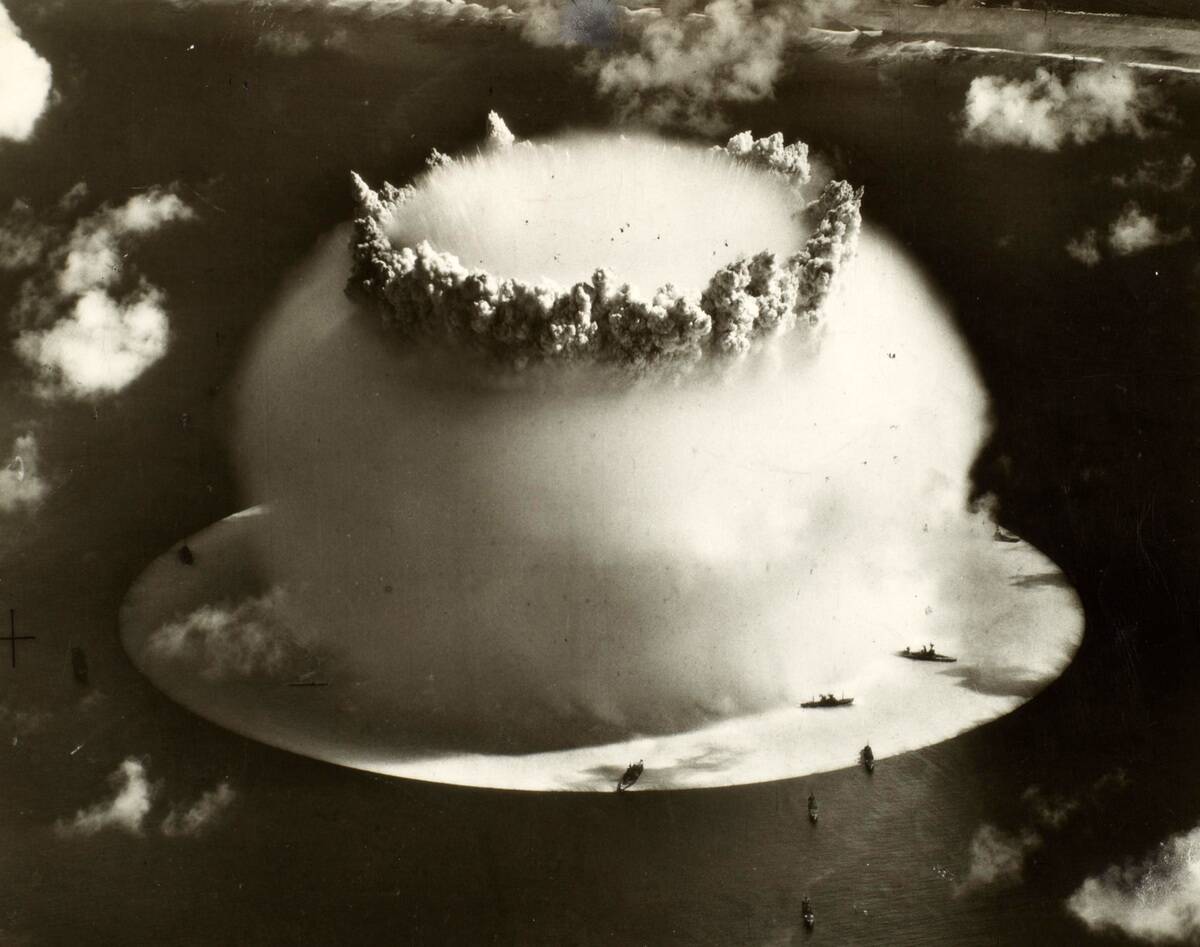
This incredibly gargantuan blast was the result of a 1946 atomic weapons test at Bikini Atoll. It was one of two tests within the Crossroads series, and another three would follow as part of the Sandstone series in 1948.
However, those who remember the ’50s will know that it was the banner time for Atomic tests like this, as 188 of them were conducted by the United States alone throughout that decade. Nonetheless, the post-war atomic tests and the destruction they weaved all started here.
A Growing New York
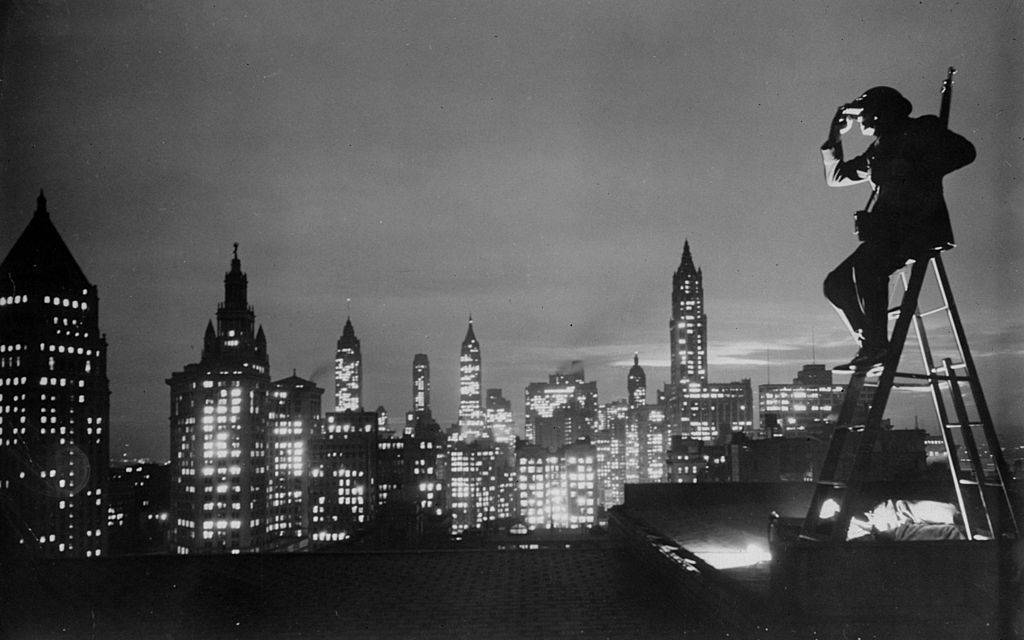
Featured here is roof spotter Benjamin Franklin as he takes a break and admires the budding New York skyline at the end of a long day of work. Not only has the city evolved over the decades, but clearly so have safety procedures.
It doesn’t seem like Franklin is wearing any safety gear at all that might prevent him from a long fall to the bottom of the street. Little did he know this snapshot would become a famous picture one day either!
What Happens In Vegas, Stays In Vegas
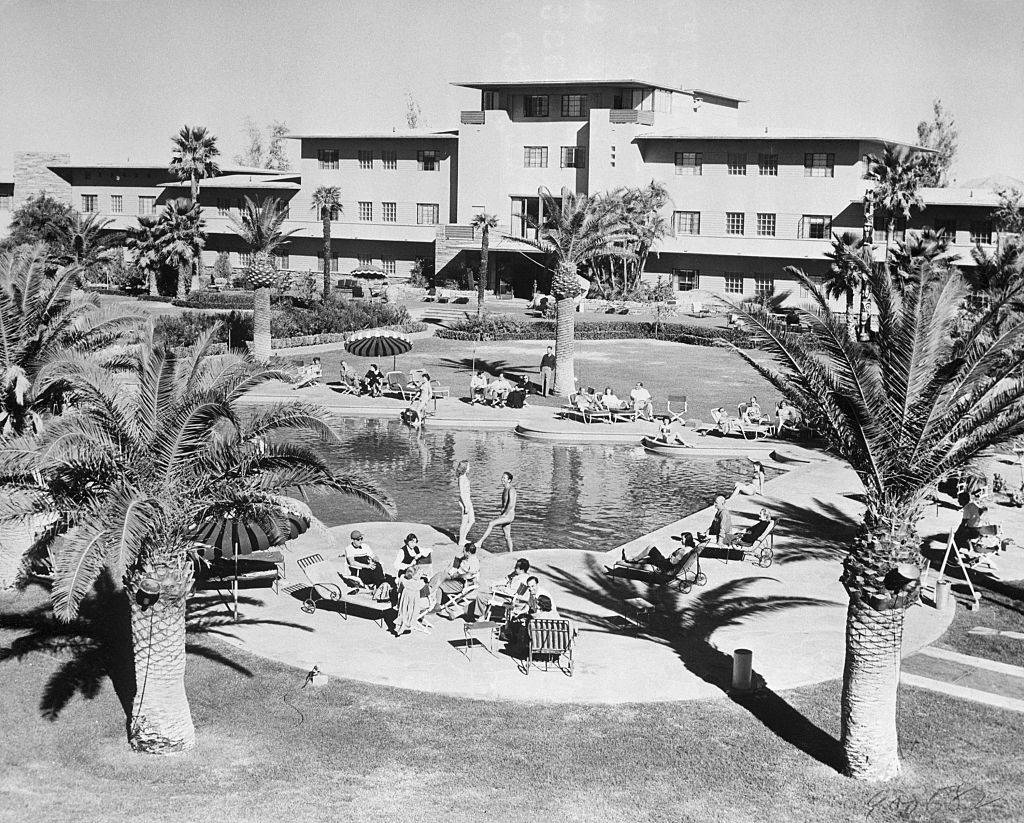
After the ending of World War II, and leading up to the 1950s, the economy began to boom, and people became more accustomed to a comfortable lifestyle. Pictured here is the famous Hotel Flamingo located in Las Vegas, Nevada, in 1949.
At the time, it was considered to be one of the most beautiful establishments of the world and welcomed the rich and famous to come and lay out by their pool, shaded by the palms.
Being A Sailor Was Dirty Work

Being out on the open seas has never been the cleanest of jobs. You’re stuck on a ship in the middle of nowhere, crammed in with a bunch of other men, with no place to go.
Even in the 1940s, it is clear that this was a job not for the faint of heart. Pictured here are a group of grease-faced sailors as they share water from a bucket on a ship in 1940.
Surfin’ U.S.A.
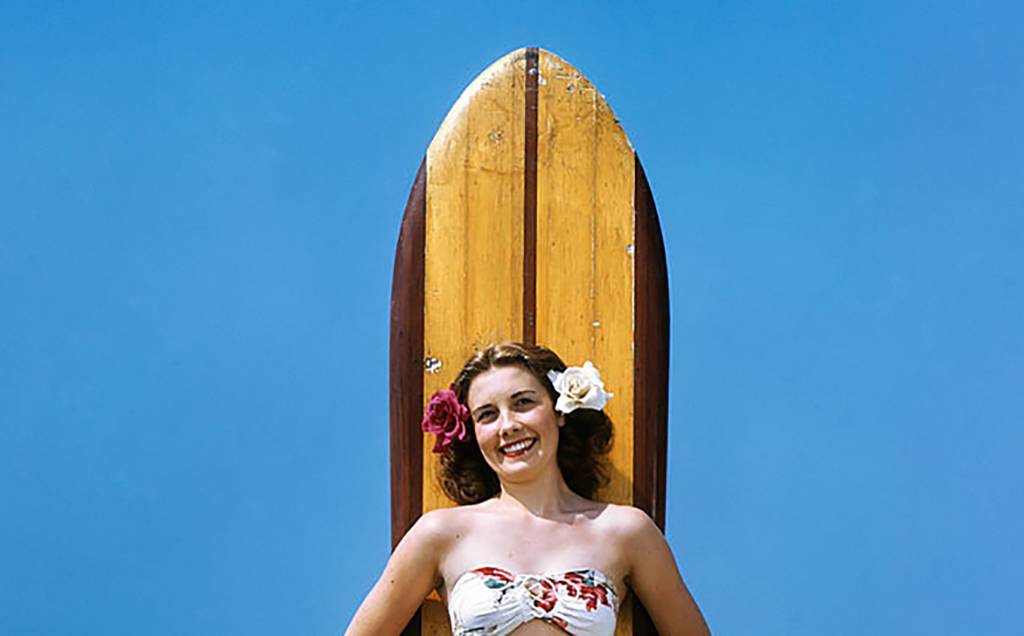
At the end of the 1940s and leading into the 1950s, the United States wasn’t as on guard as it was during the war. This gave people the opportunity to spend time doing the things that they enjoyed doing and inventing some hobbies of their own.
During this time, beaches began seeing the emergence of surfing and the surf culture that would soon come to dominate many California shorelines in the coming decades.
A New Way To Ride In Style
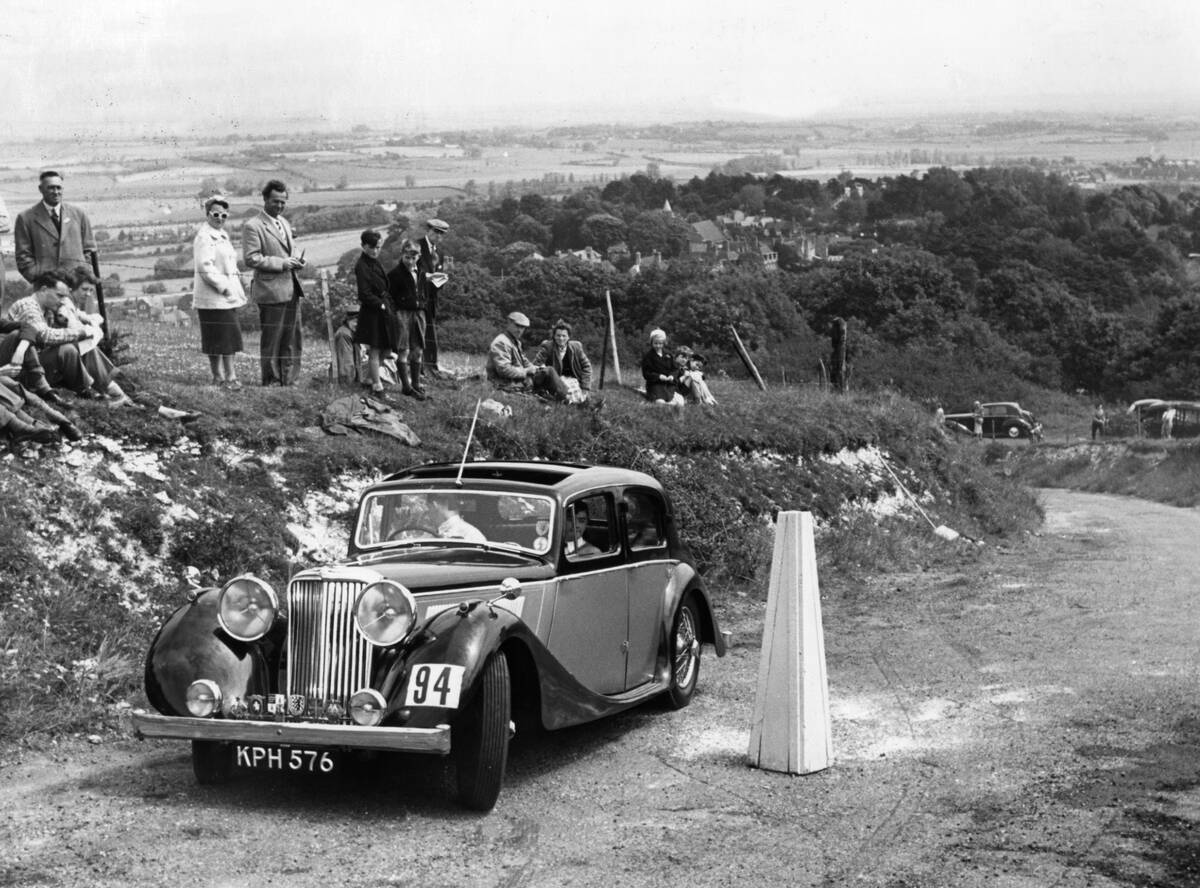
Although this photo comes from the 1954 Eastbourne Rally in England, the car featured in it is emblematic of the designs of the ’40s. As soon as the war was over, this fine looking automobile would have been the envy of all the neighbors.
That’s because this was the 1946 Jaguar, which marked a watershed moment for the company, as it had only officially become Jaguar Cars the year prior. It was previously called SS Cars, as Jaguar’s original purpose was to build motorcycle sidecars under the name Swallow Sidecar Company.
These Don’t Look Like They Were Built Decades Apart
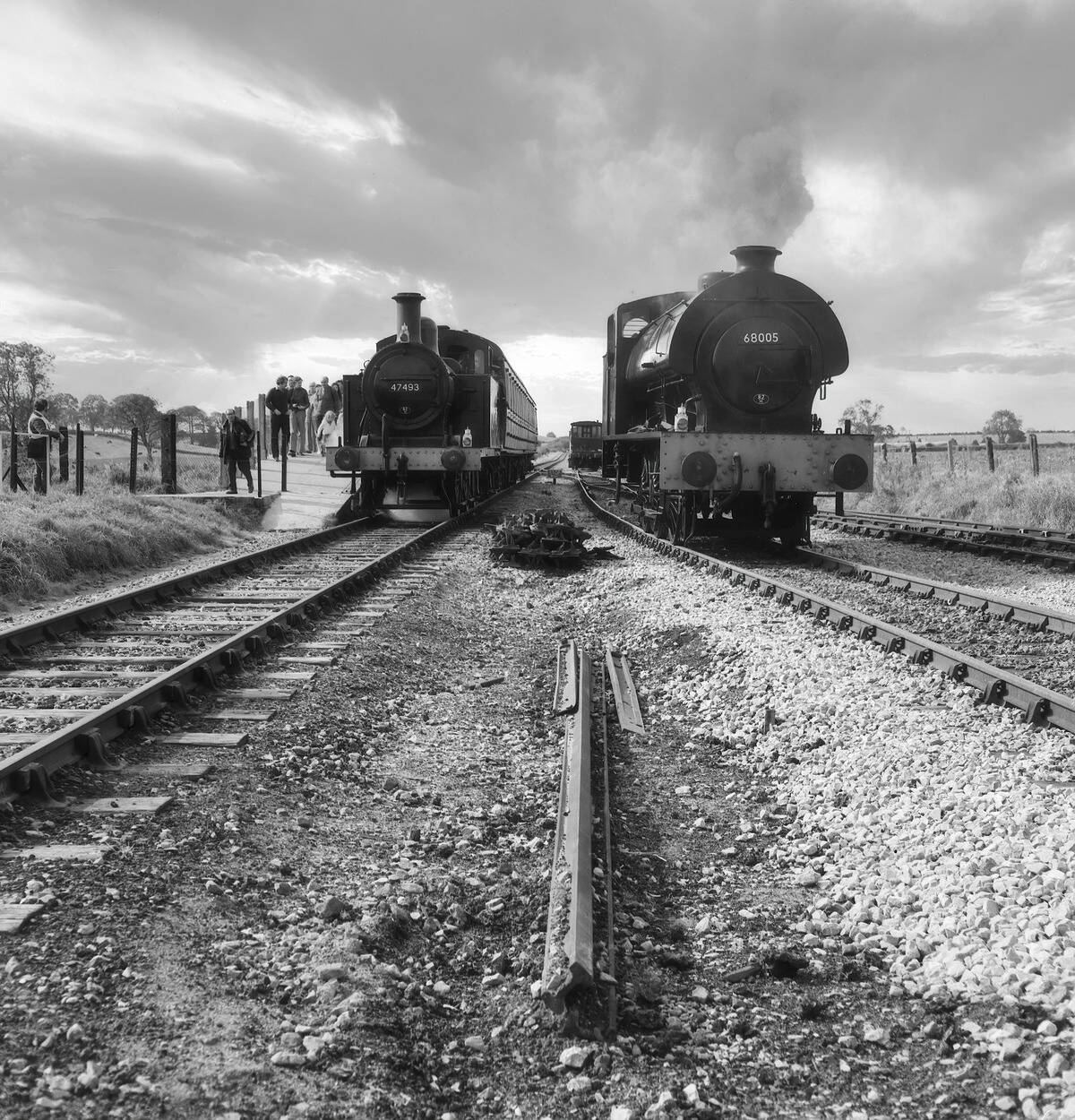
Although a true trainspotter likely doesn’t need to be told this, the subtle differences in the designs of these respective trains show a deceptively large gap in time before their construction. Granted, the fact that they were made by different firms is a factor as well.
Both of these trains are British, but the one on the left was built in 1927 by Vulcan Foundry ltd, while the one of the right was built in 1945 by Robert Stephenson & Hawthorn. So the design on the right would seem brand new at the time.
Danny Kaye Giving The People What They Want
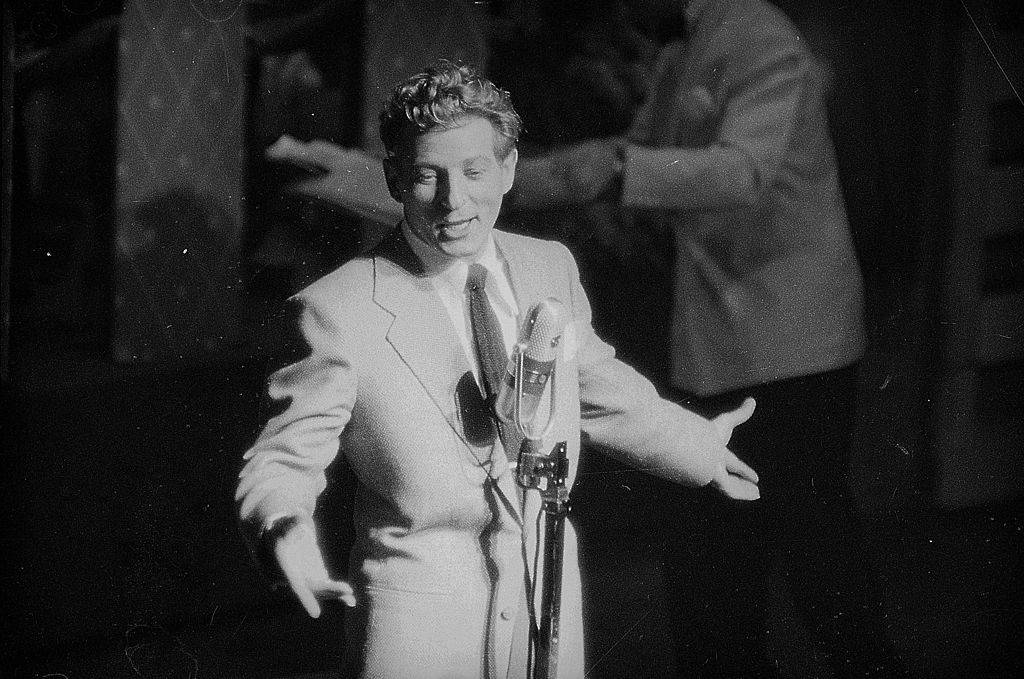
In the 1940s and the 1950s, Danny Kaye was a signature in the entertainment industry. Not only was he talented, but he was a jack of all trades, being an actor, dancer, singer, comedian, musician, and philanthropist.
Over the course of his career, he starred in 17 films and was known for his pantomimes, novelty songs, as well as performances of songs such as “Inchworm” and “The Ugly Duckling.” Here, he is pictured performing at the London Palladium.
Free-Climbing A Skyscraper

Being a construction worker in New York City during the 1940s certainly had its perks. Here, we see a man scaling a vertical girder with the Empire State Building in the background.
Although this worker may have had one of the most breathtaking views of the city at the moment, he probably was more focused on the task at hand. While this may look cool, this man is definitely putting his life on the line performing whatever he is doing.
A Very Different Look For New York City
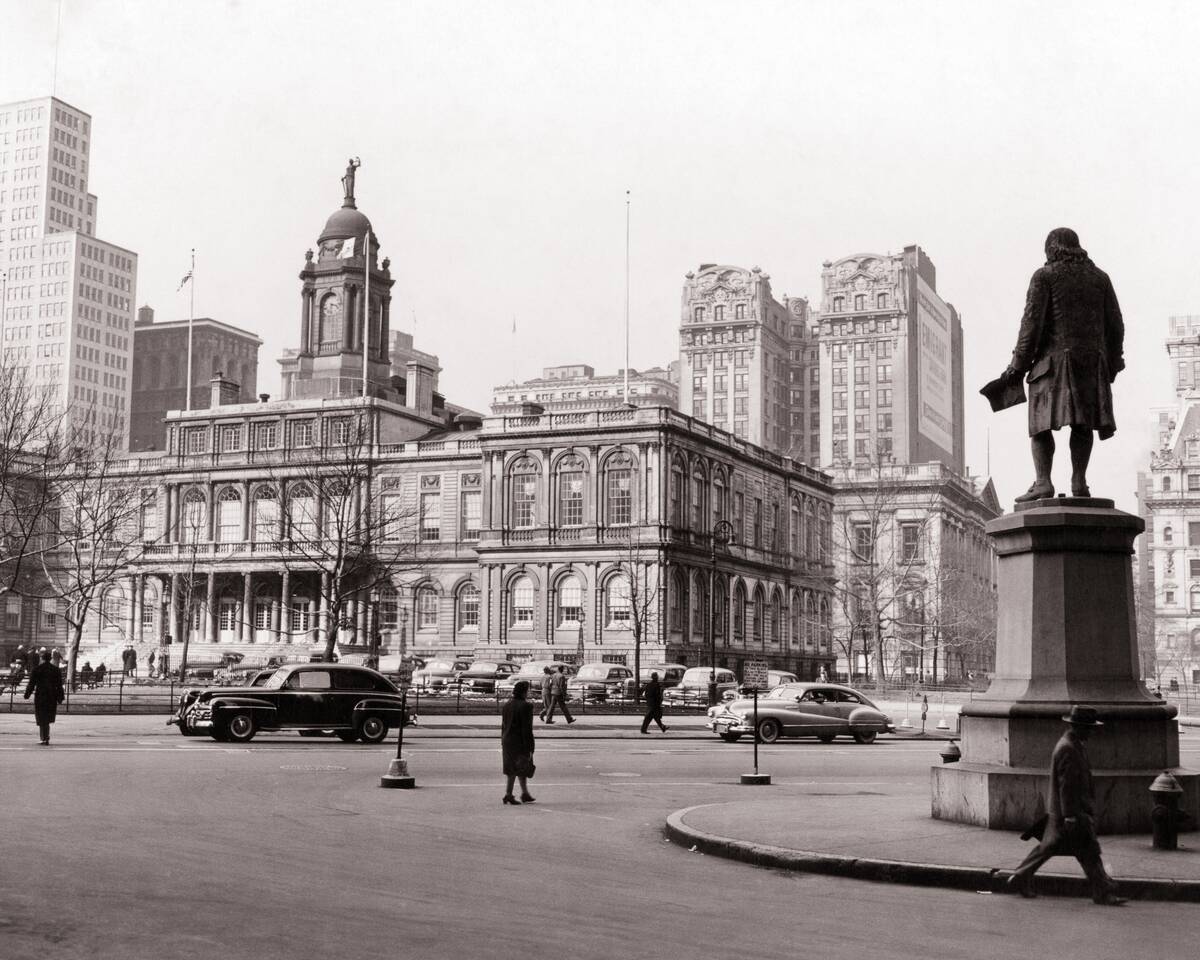
Although New York City has been the largest city in the United States since the turn of the 19th Century (Philadelphia had that title before this), that meant something much different in the 1940s than it does now. Nowadays, the infrastructure in New York City is so densely packed that they often build on top of existing buildings.
Back in the ’40s, however, it was possible to have a quiet day like this in Manhattan, where only a few people and cars are out in the streets. This statue of Benjamin Franklin would be overlooking a lot more bustle, today, as it’s hard to have much room for yourself in a city of 8.3 million people.
There Was Too Much Food At One Point
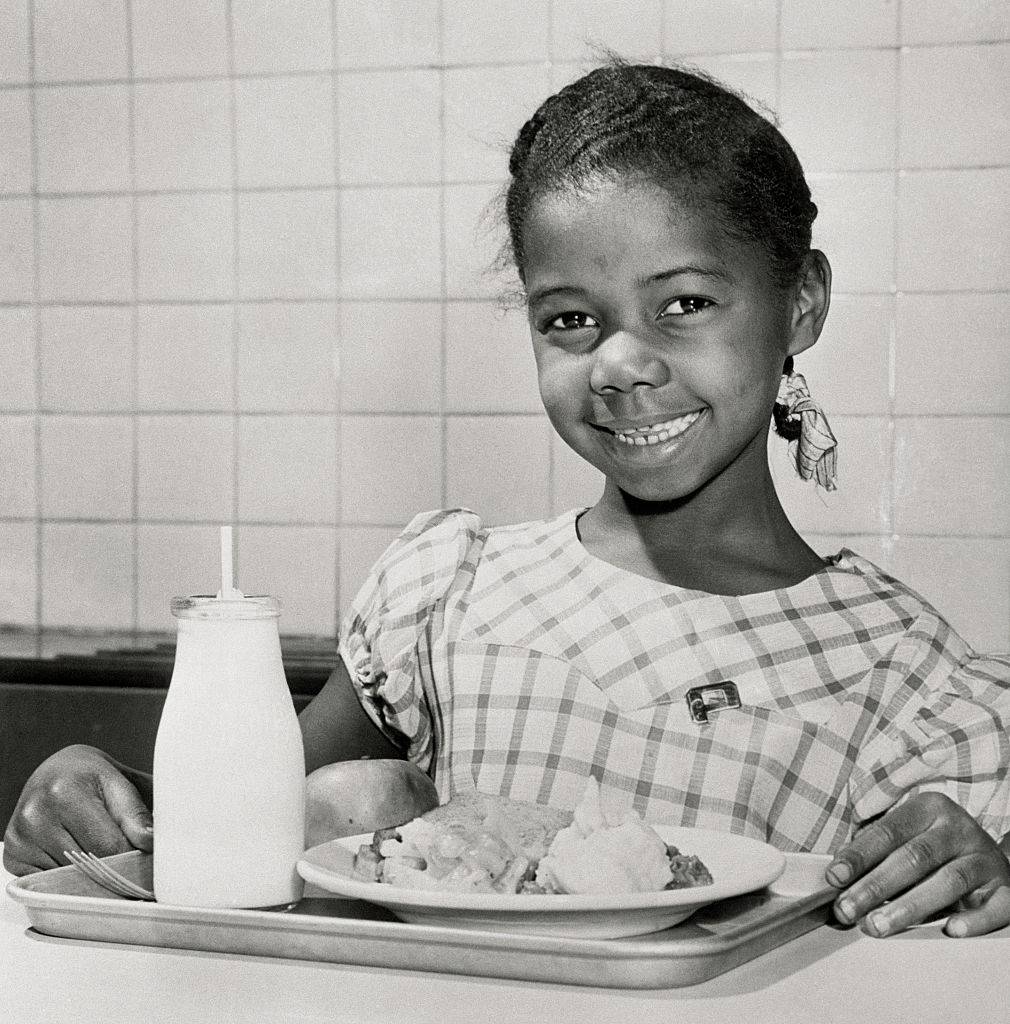
In the 1940s, there was a big surplus of food held by the Department of Agriculture as part of the United State’s government’s price support program to make sure food didn’t go to waste.
Here, a young student is showing off her full plate of food, specifically potatoes that her school received during the surplus. This was toward the end of the decade when all of the efforts were no longer going towards the war.
Gather Around For The Radio Show
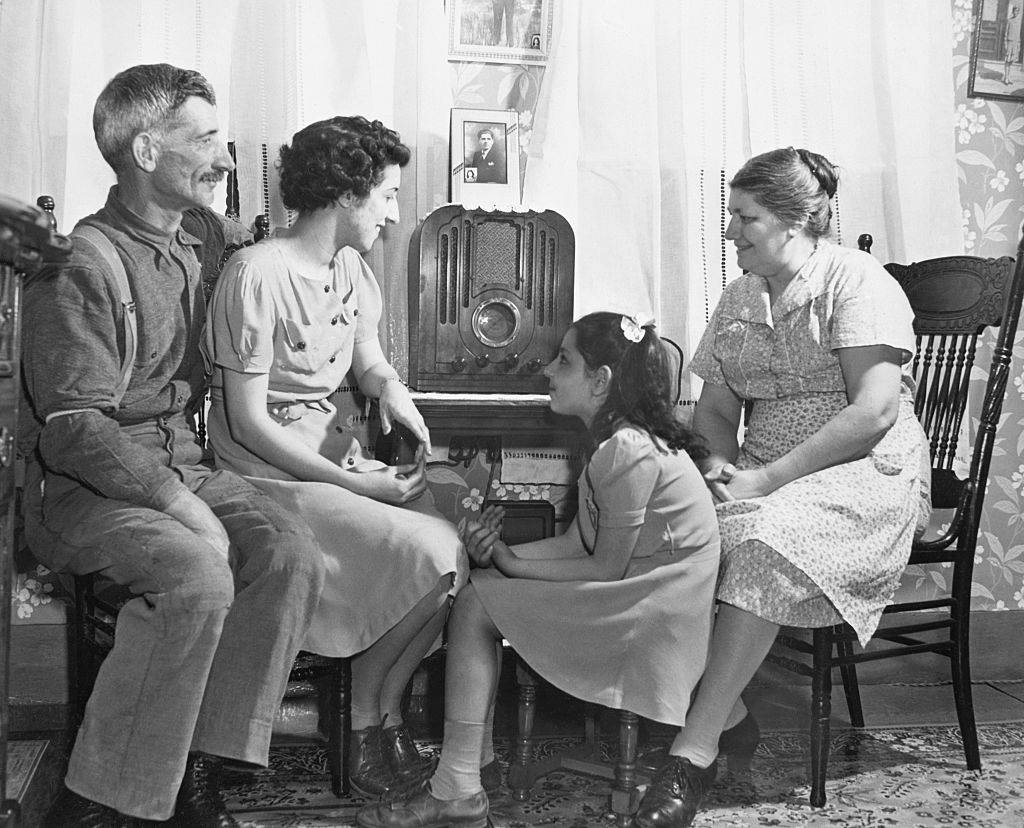
Before television was perfected and boomed in popularity between the 1950s and ’60s, individuals and families turned to the radio as a source of their news and entertainment.
The airways in the ’40s were always alive with radio shows and broadcasts that people could listen to weekly, just like people follow their favorite television series today. Pictured here is a family in Provincetown, Massachusetts as they gather in the living room to listen to their favorite program together.
The End Of An Era That Will Be Remembered Forever
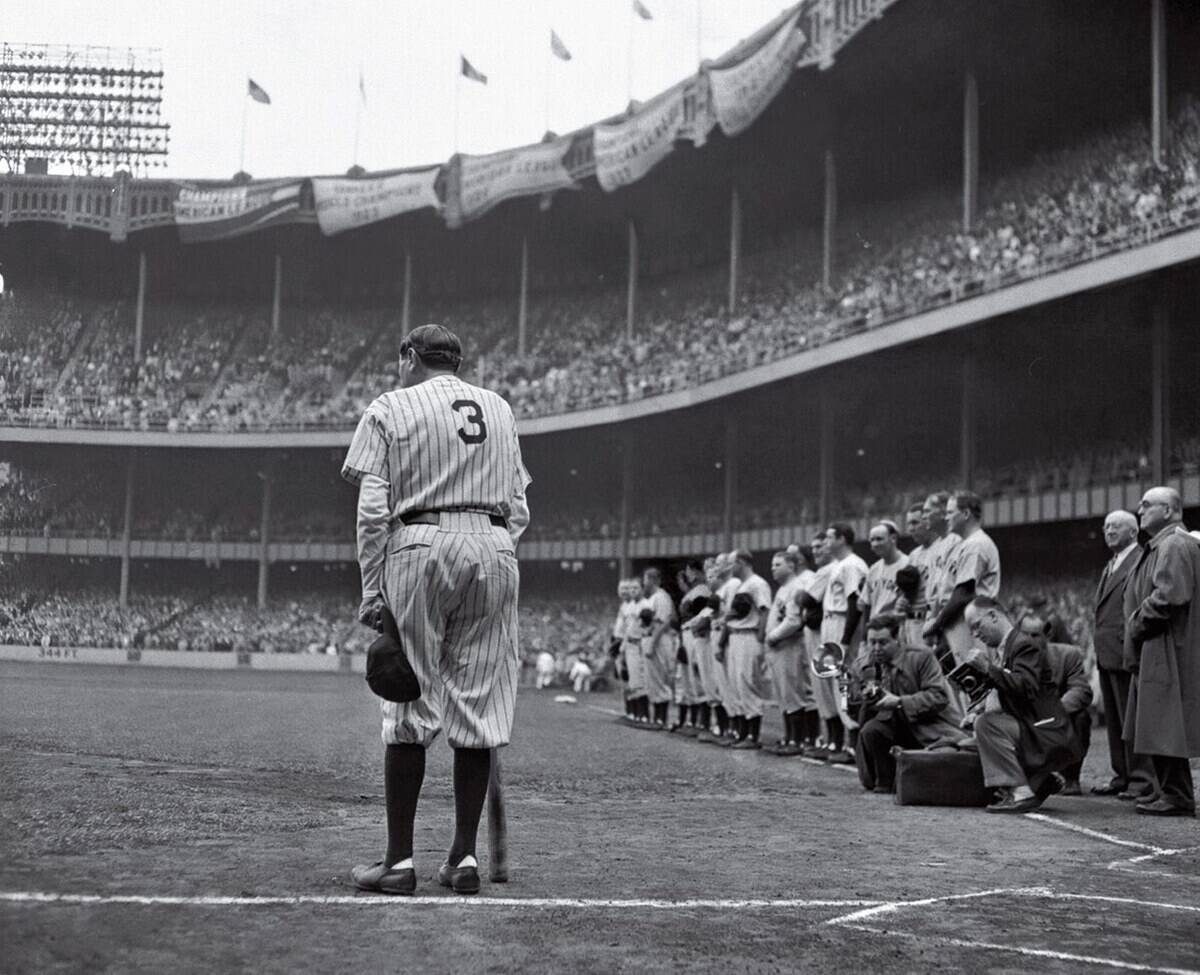
By the time this photo was taken, Babe Ruth had been retired from Major League Baseball for 13 years. Yet, while he didn’t exclusively play for the New York Yankees throughout his career, the 15 years he played with them were easily the most legendary for him and loomed large over the team’s entire history.
Two months before he passed away, that legacy was honored at this event held at Yankee Stadium on June 12, 1948. Titled “Babe Bows Out,” this photo captured the moment where Ruth graced the stadium one last time to retire his number. The photo eventually won the 1949 Pulitzer Prize for Photography.
Dancing Was The Thing To Do
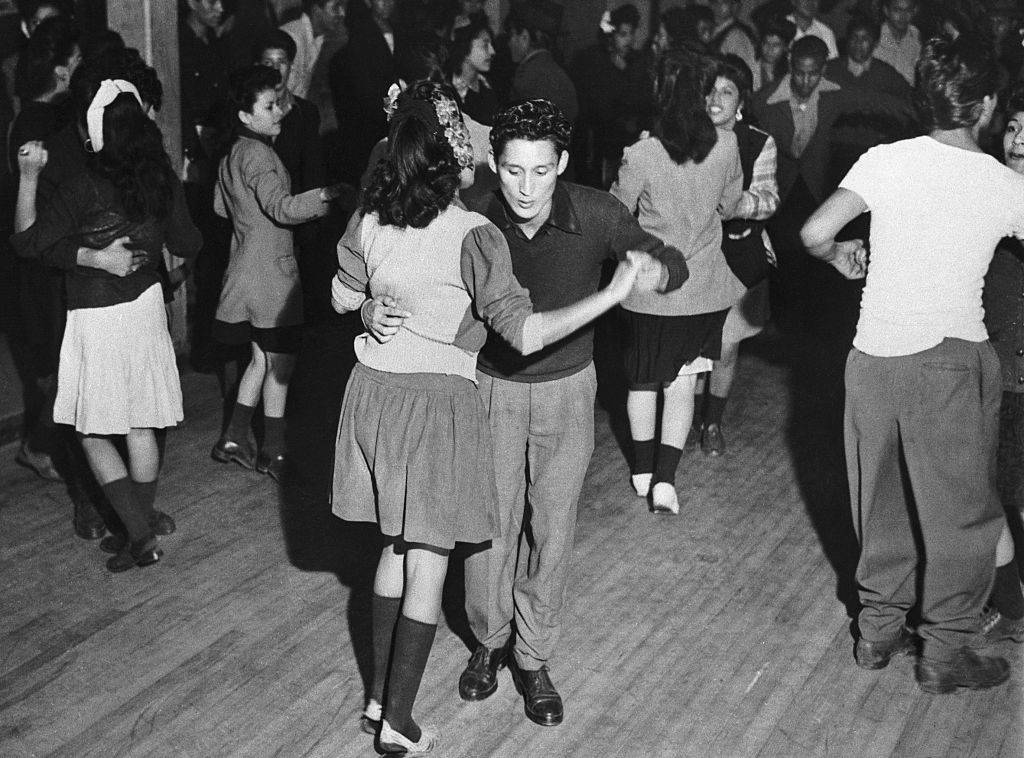
While dancing is still an extremely popular past time today, back in the 1940s, it was a community-wide event, with establishments clearing an area for a dance floor. Usually attended by a younger crowd, it allowed the youth to cut loose and have some fun on a weekend.
While these were meant to be wholesome events for teenagers, things didn’t always go as planned. This picture was taken during a dance in Los Angeles, California, in 1943.
We Were Still Tunneling Underground The “Old Fashioned” Way
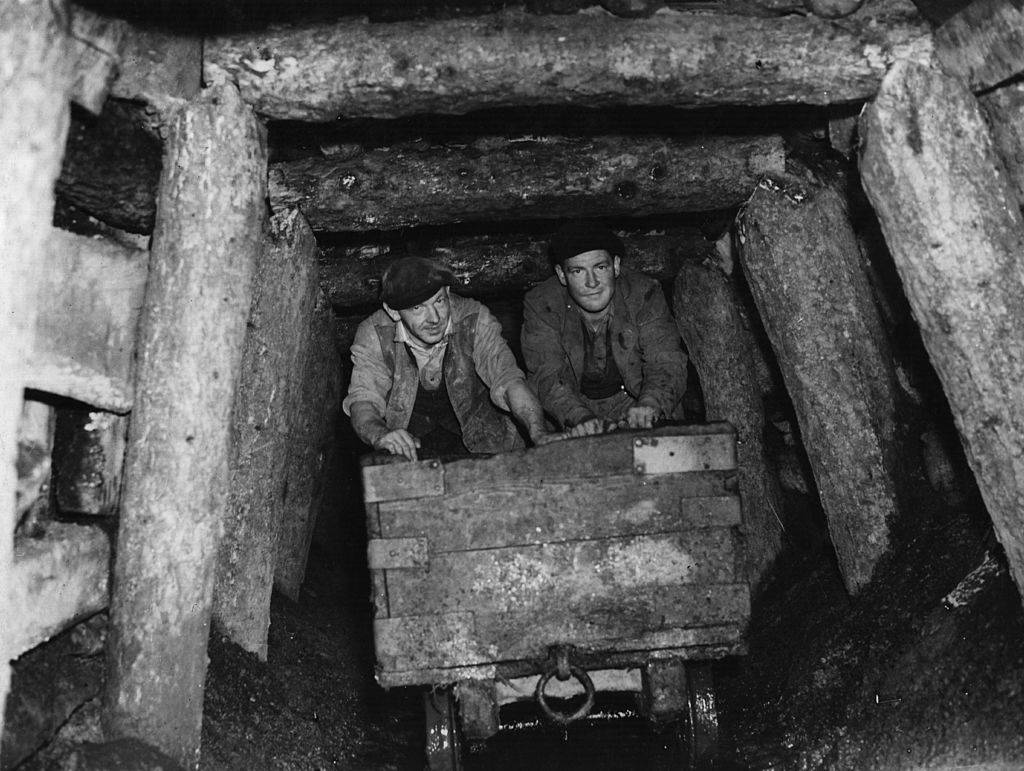
Even during the 1940s, some people were still mining the earth the same way that it had been done for hundreds of years. These workers did their jobs in extremely hostile and hazardous conditions, leading to many of them not living very long lives.
Here, two miners are wheeling a cart out from a mine shaft that’s held together with nothing but pieces of wood. This picture is estimated to have been taken back in 1941.
The Humble But Promising Dawn Of Television
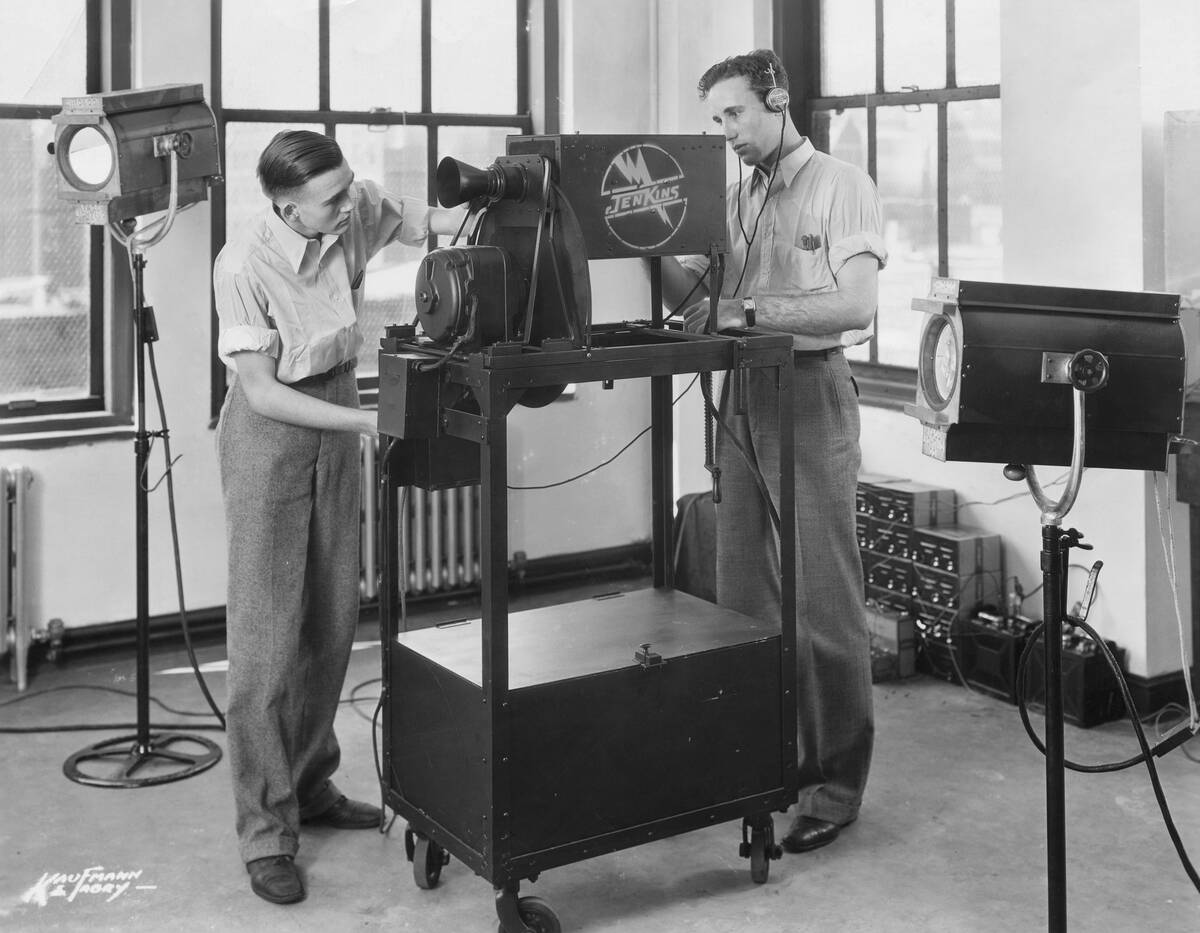
Television was in its infancy during the 1940s and the right infrastructure to make it a widespread phenomenon rather than an experimental curiosity wouldn’t truly be put in place until the 1950s. Still, early adopters like these young men were more prepared for that time than most.
These are students of the Coyne Electrical School in Chicago, Illinois, and they’re likely learning just as much about how early TV cameras like this work as they are about how to use them. The school began in 1899 but was rebranded as Coyne American Institute in the 1960s after a merger with the American Institute of Engineering and Technology.
Comics! Comics! Comics!

A major preoccupation, especially for young boys, was diving into as many comics as they could get their hands on. Not only were they accessible, but they were cheap, provided tons of entertainment, and new ones were always coming out.
During the 1940s, many comic companies, such as DC Comics, began to make a huge impact on the entertainment industry, with some of the most popular comic book heroes ever coming into existence.
The War Was Over But Their Fight Wasn’t
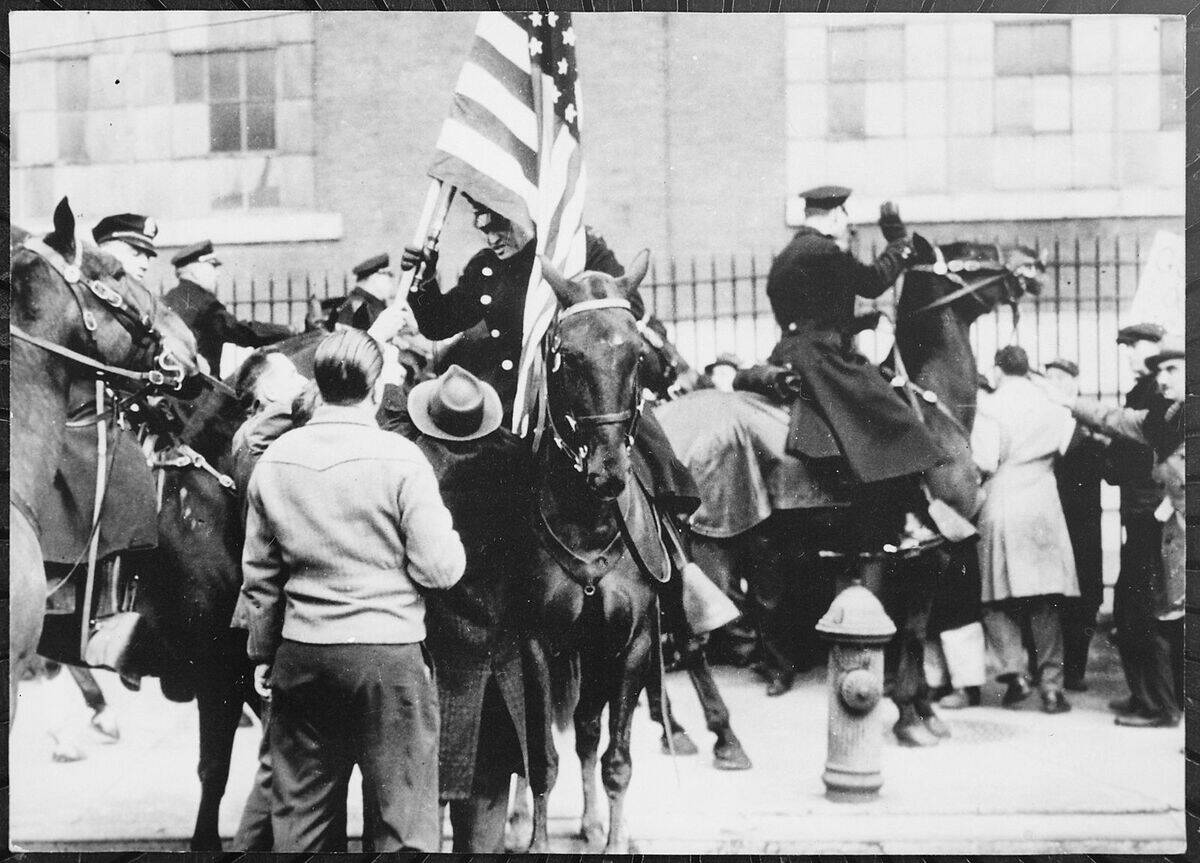
After the rationing and and austerity measures needed for World War II had ceased, these workers at a Philadelphia electrical plant clearly felt that it was high time for their rights to be respected. Yet, while they went on strike in 1946, that clearly didn’t happen unopposed.
It’s unclear how the situation escalated to this point, but these mounted police officers were definitely in a heated clash with the strikers when this photo was taken.
Interior Design Became More Widespread
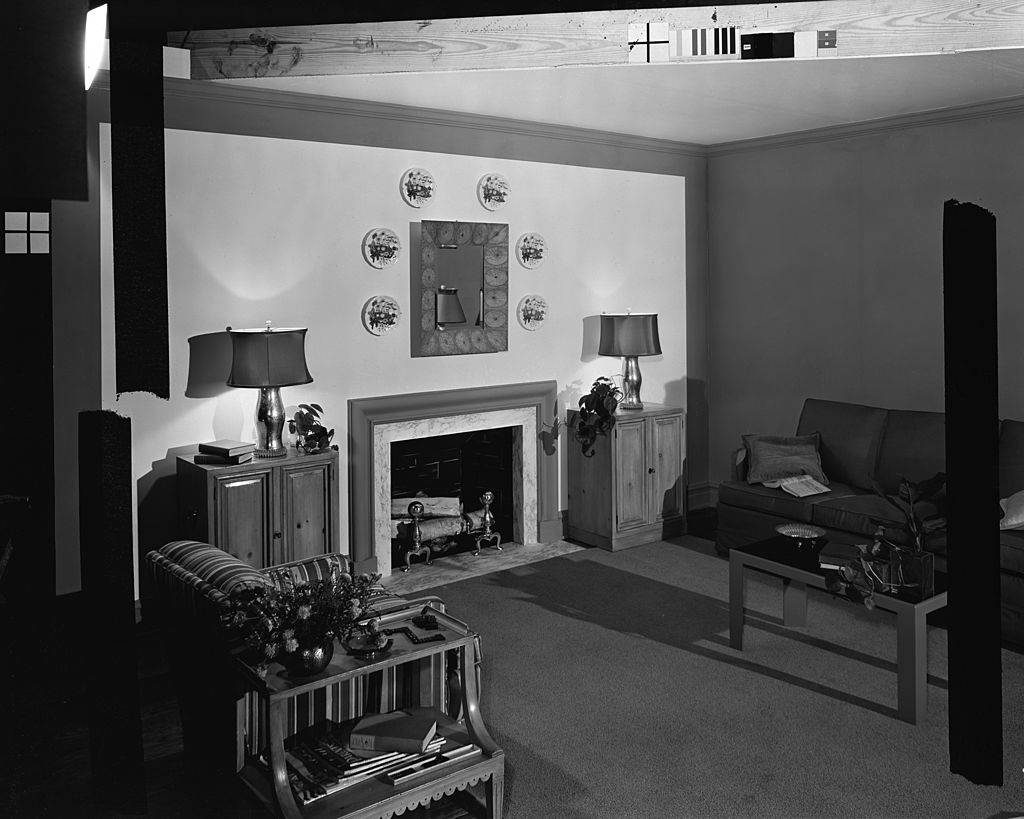
Following the Great Depression and World War II, the 1940s also saw an increase in interior design, not only for the rich but also for the middle class. Not all families were struggling to put food on the table, so they could afford to spruce up their homes.
Incredibly, some of the popular designs back then can still be seen in some homes today that are going for a unique look. Pictured here is the interior of a home in Chicago, Illinois, from 1946.
Train Wheels Needed To Be Replaced Sometimes
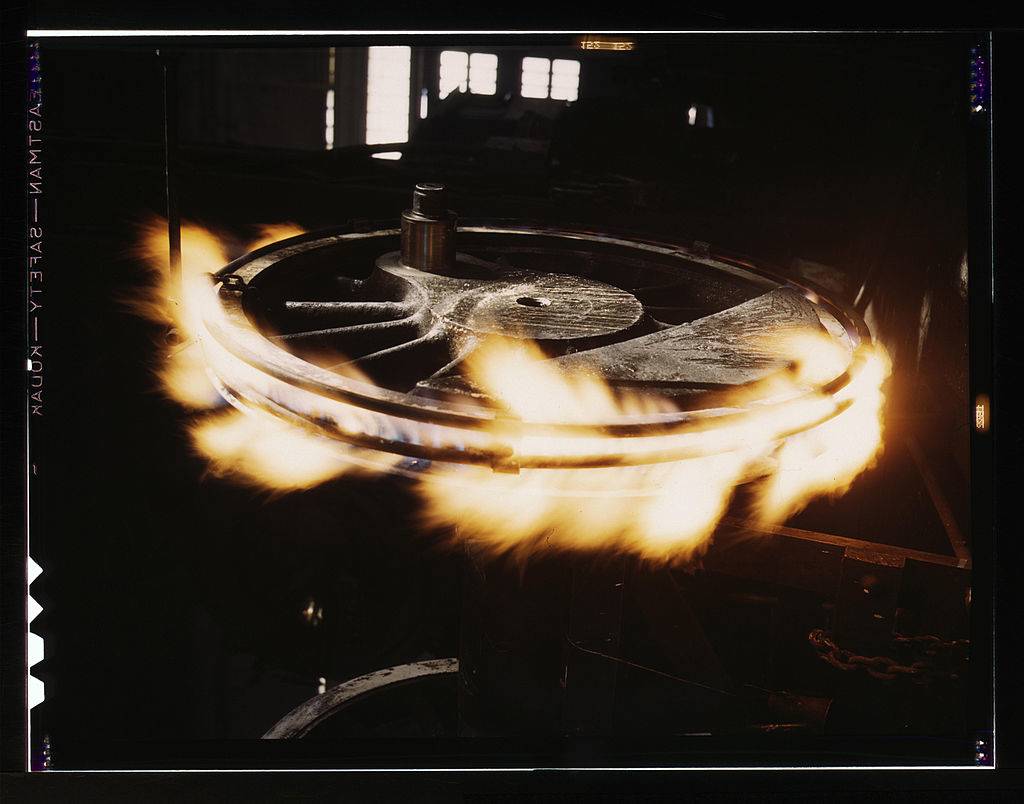
By the 1940s, trains were one of the biggest modes of transportation for people, livestock, and other goods. Of course, they could still be temperamental at times and needed repairing, such as changing the driver’s wheel!
This is a picture of a locomotive driver wheel that’s being ready to be fitted on a new tire. The process involves heating the tire with gas until it expands enough to fit over the drive wheel. Interesting stuff!
This Is Quite A Big Haul For One Kid
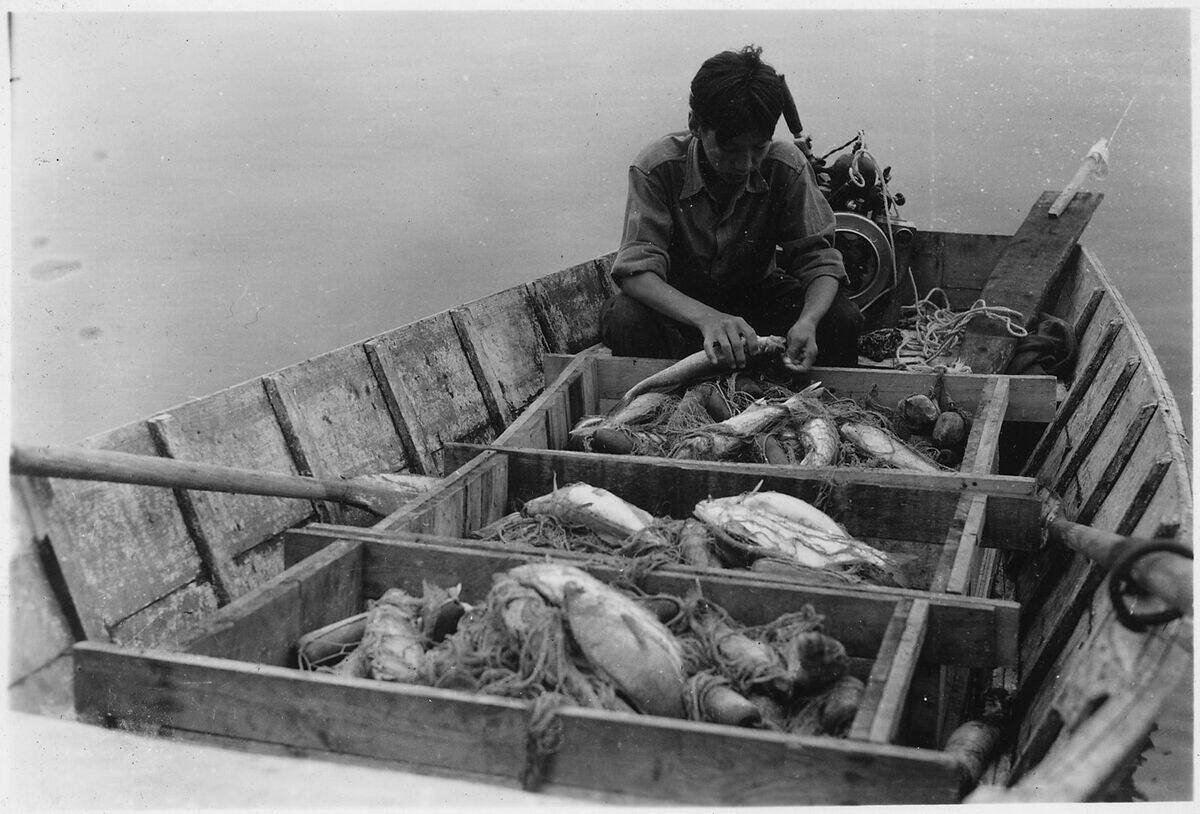
For as long as people have lived near water, they’ve fished. It’s also hard not to imagine that from the very beginning, there were people with an uncanny talent for it who mystified everyone else.
Despite the fact that this teen in Minnesota was armed with simple means when this photo was taken in 1941, he came home with an impressive load of fish. This would be a worryingly light yield for a commercial fishing boat, but it’s incredible for such one person.
An Ancient Art That Was Still Widely Needed
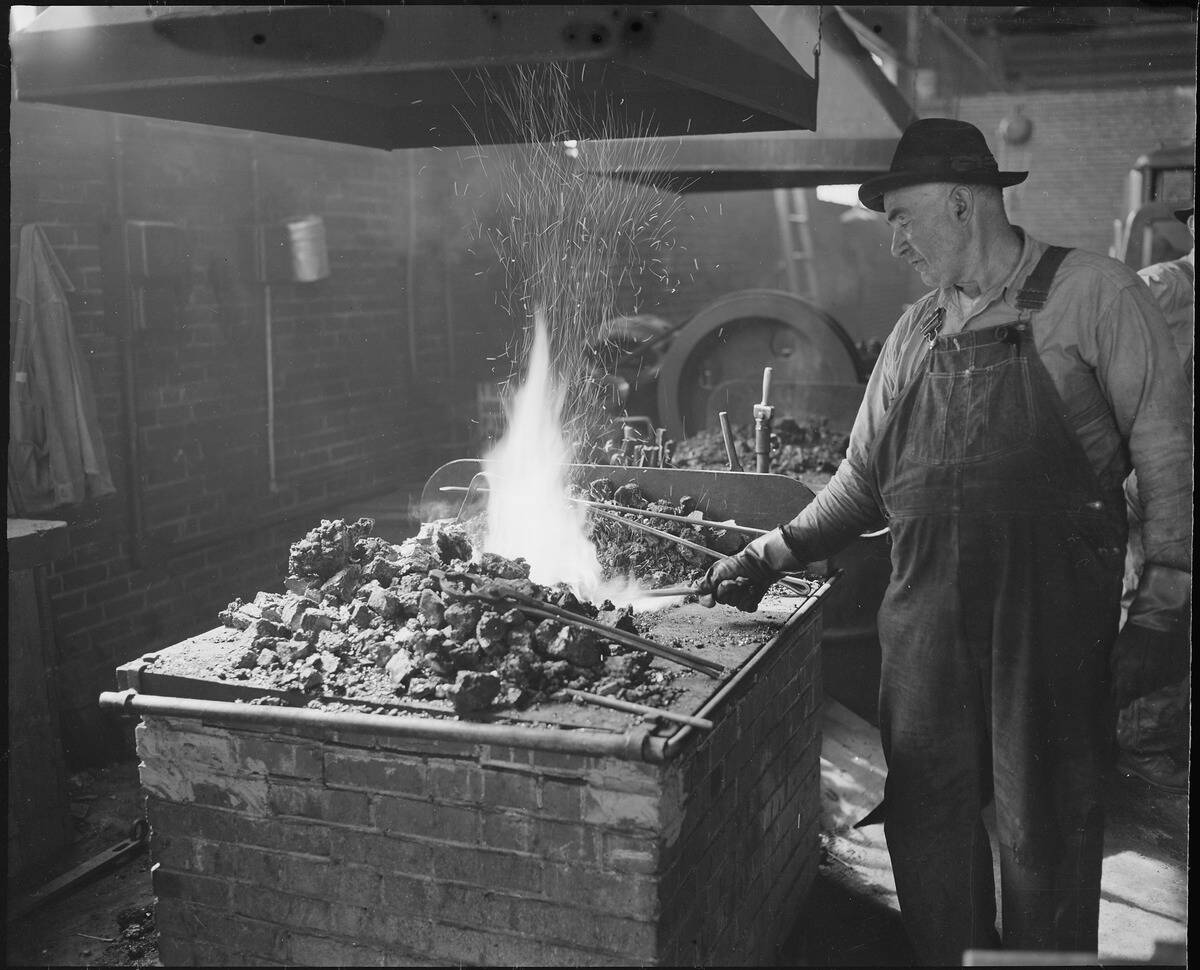
This man was a blacksmith working for the Pocahontas Corporation in Bishop, Virginia back in 1946. So, although this photo was logged the Solid Fuels Administration For War after it was taken, that means his work was happening in peacetime.
Although only other blacksmiths could tell exactly what this person is doing, his flaming forge certainly looks mighty as he does it. That’s definitely not a job for those who can’t take the heat.
This Would Have Been Considered Risqué At The Time
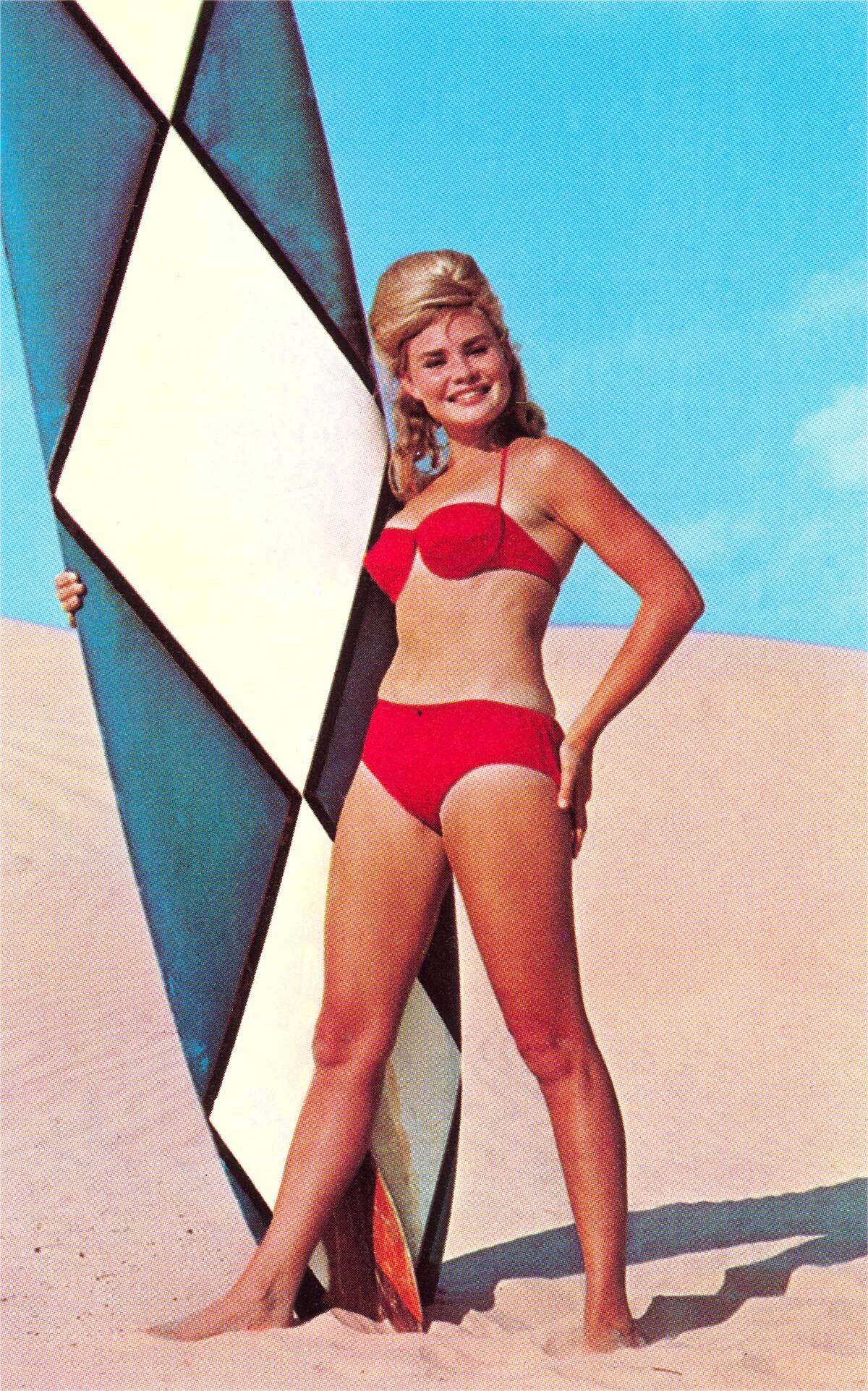
Although surfing and beach culture was about to take America by storm, the beauty and modesty standards that seem overly rigid now weren’t quite gone by the 1940s. For that reason, this photo of a woman in her undergarments would have been considered a boudoir photo to be kept private.
By the way, this photo does not depict two women acting amorously toward each other. If you look closely, you can see that she’s sitting in front of a mirror.


